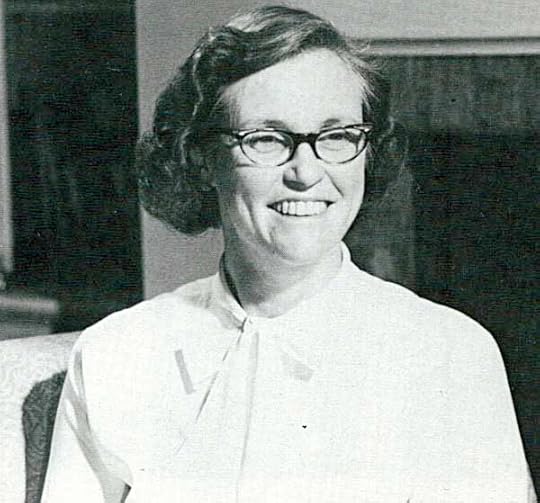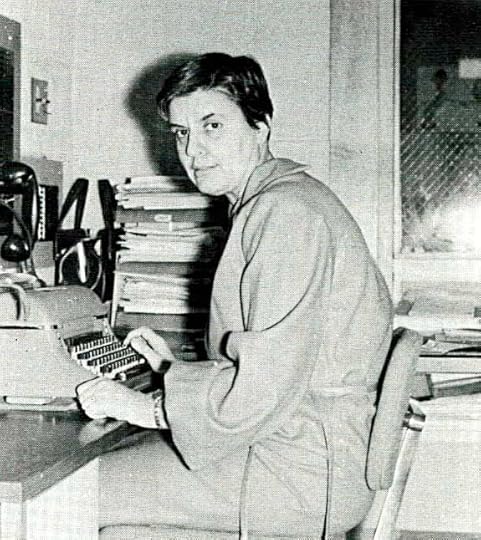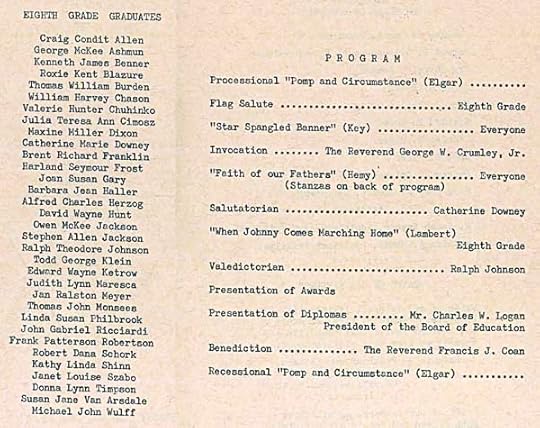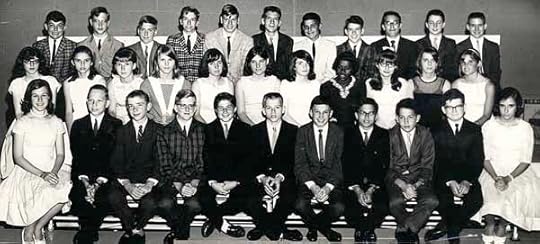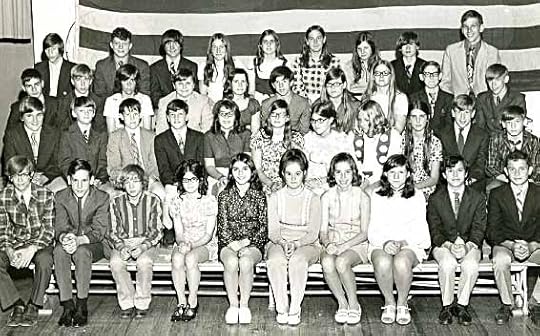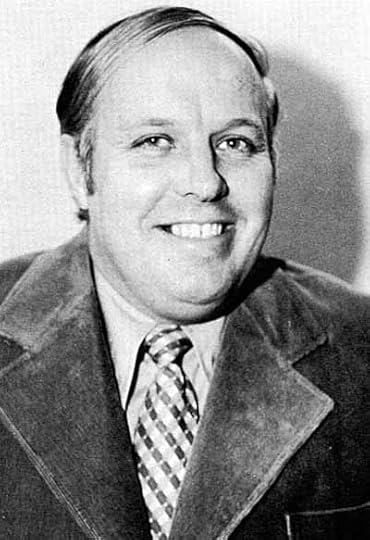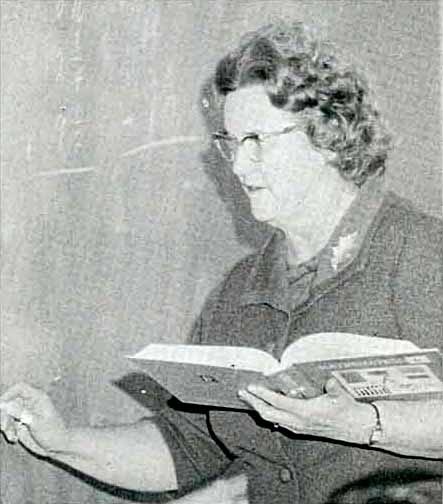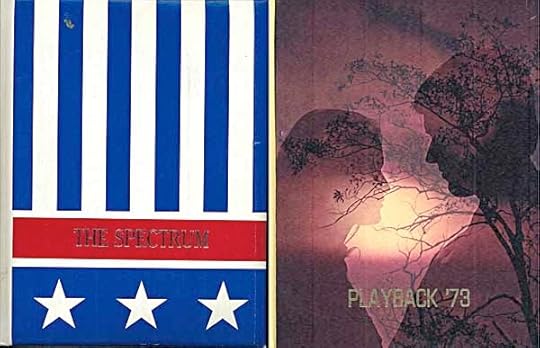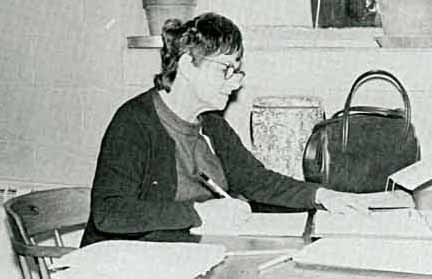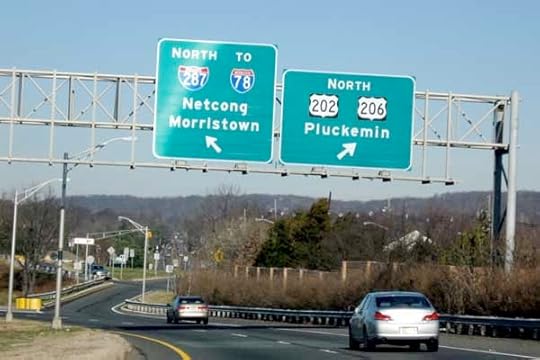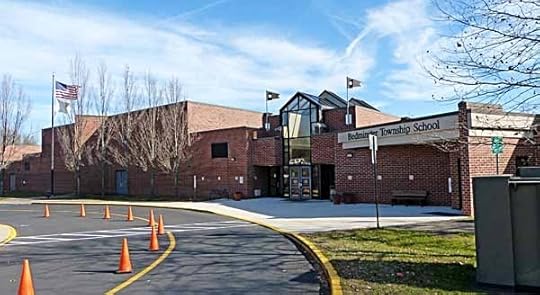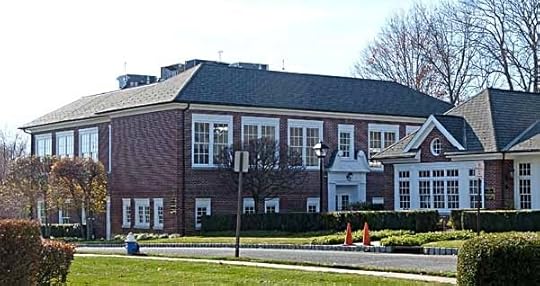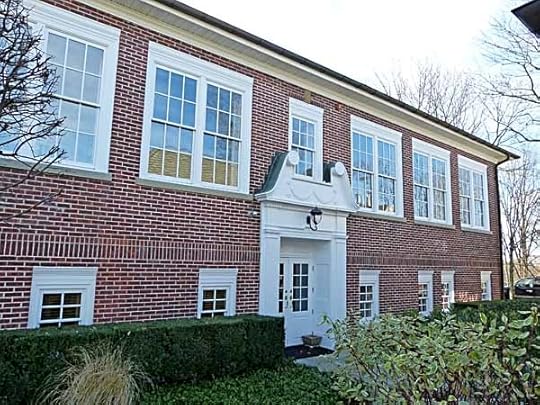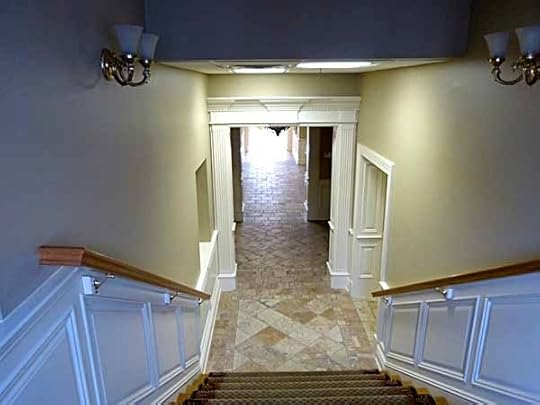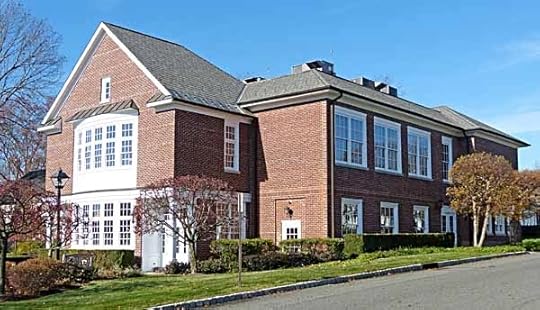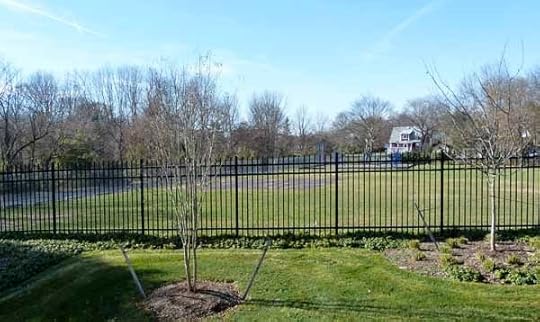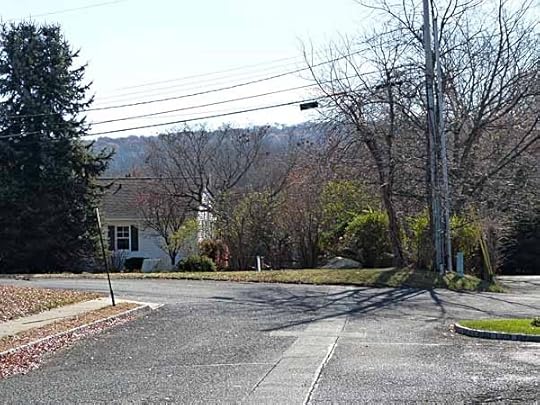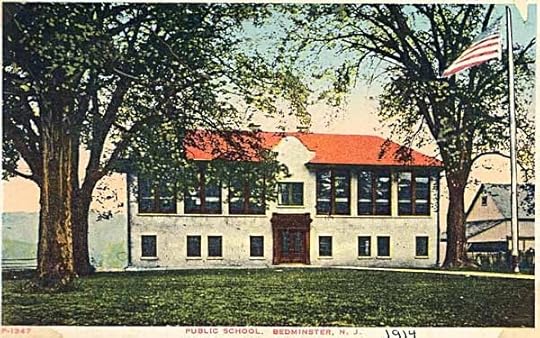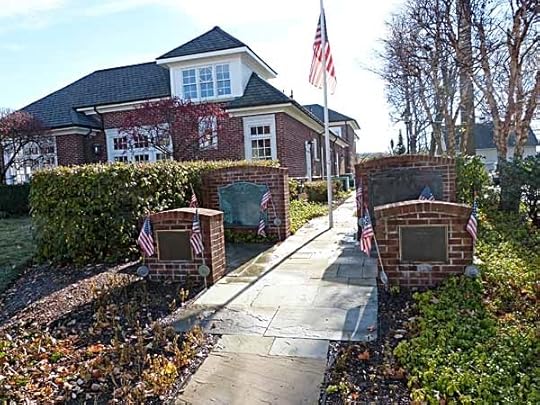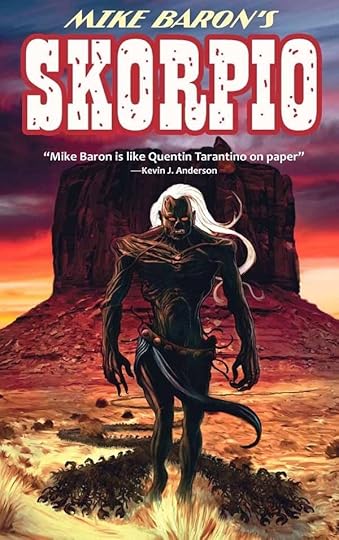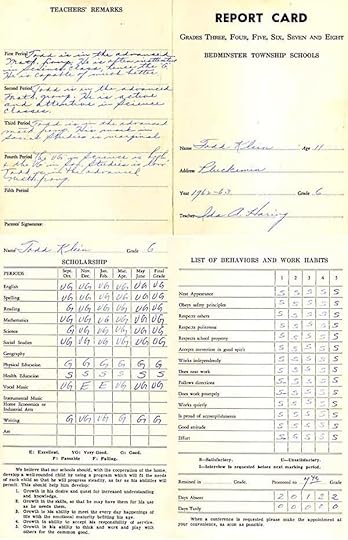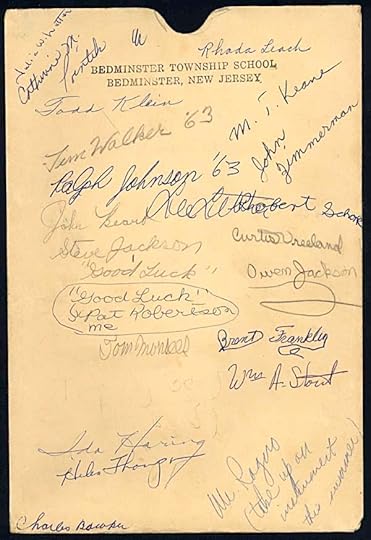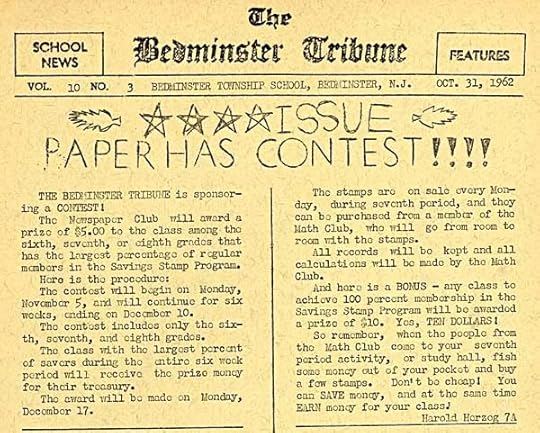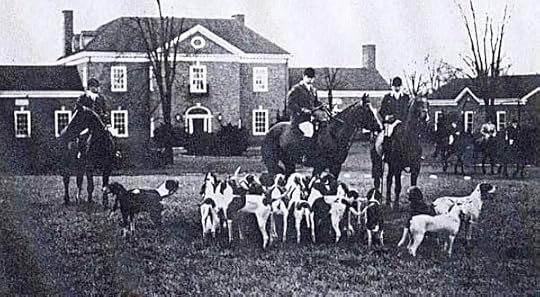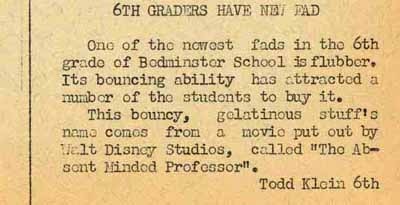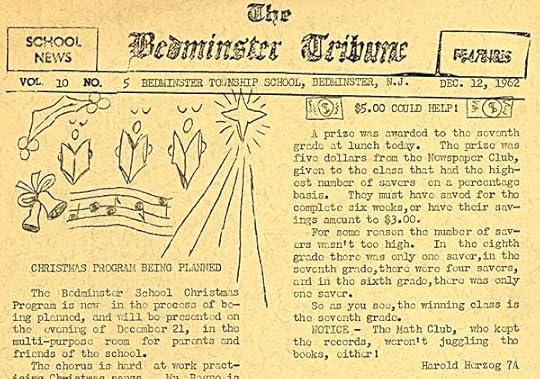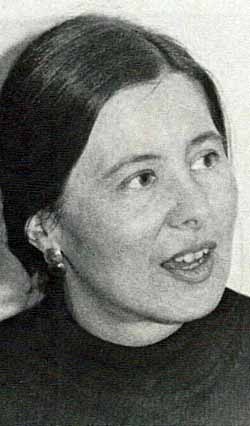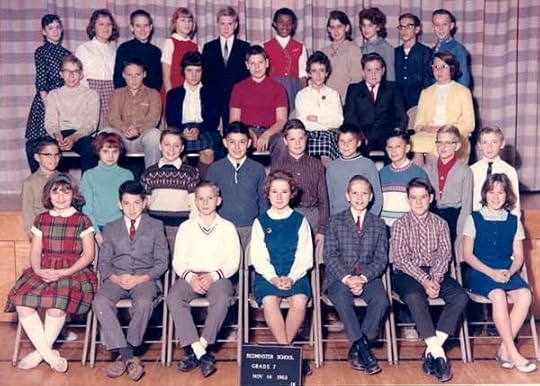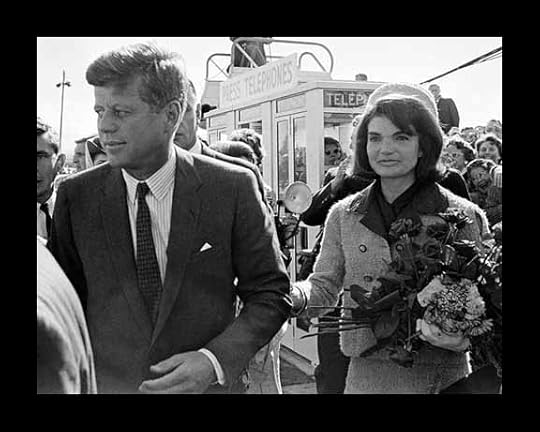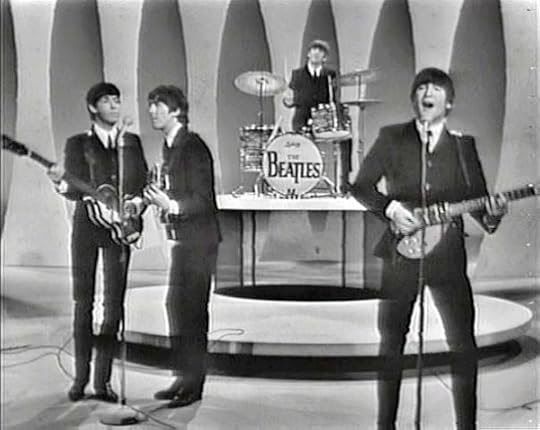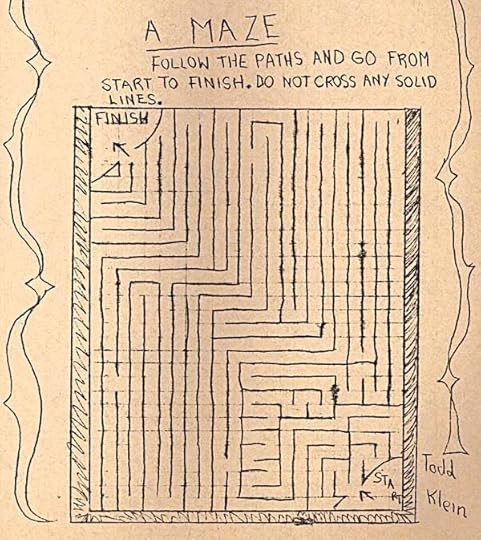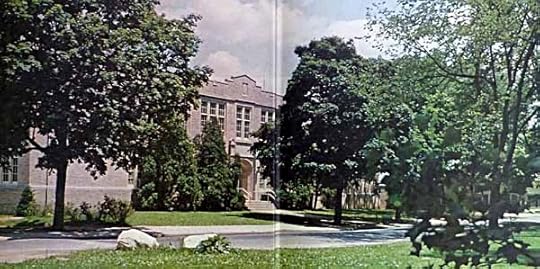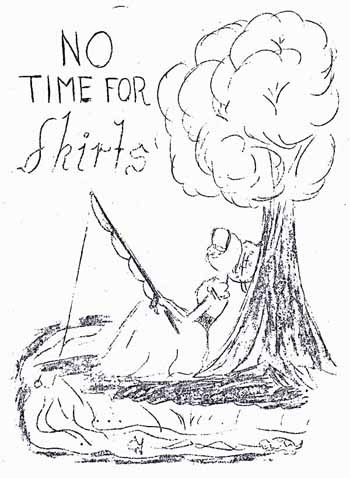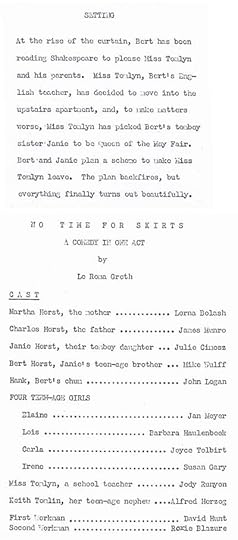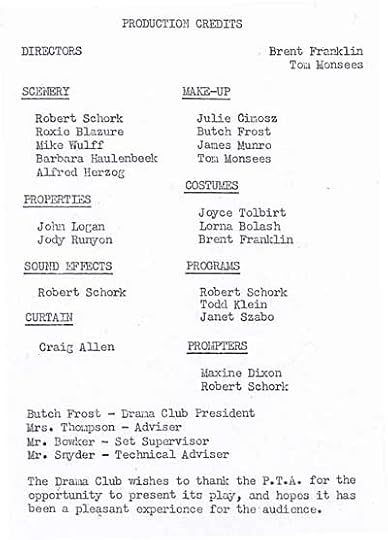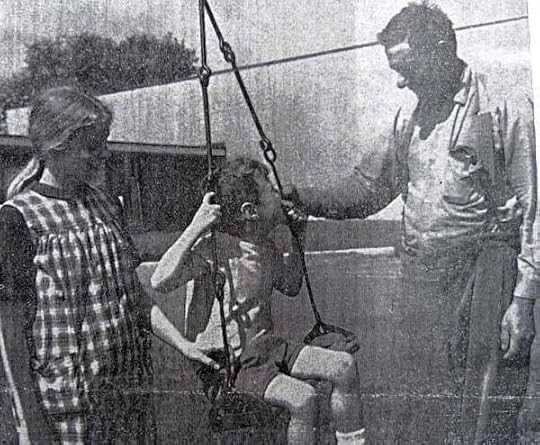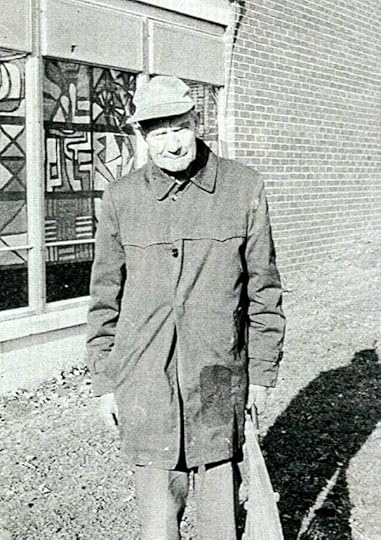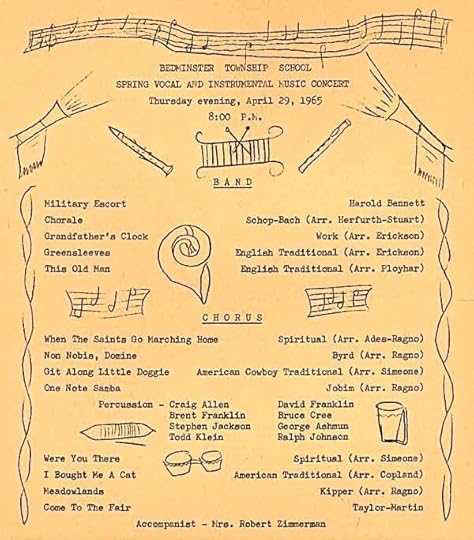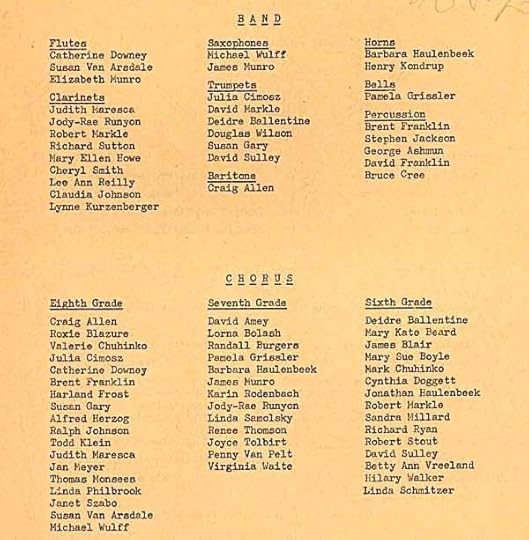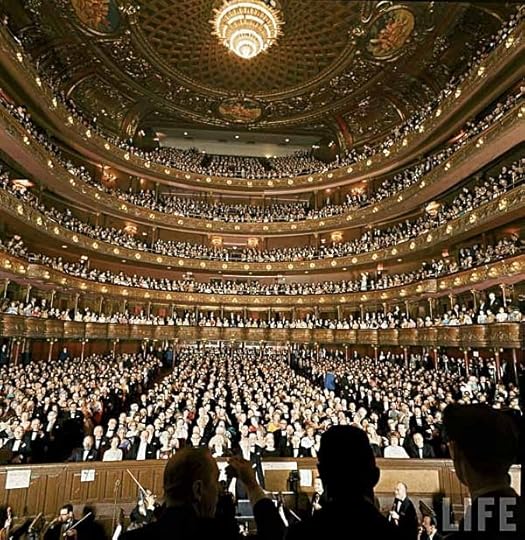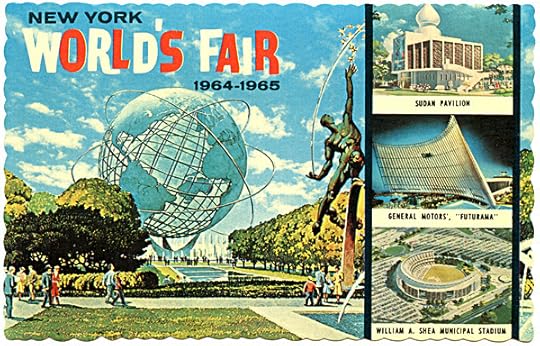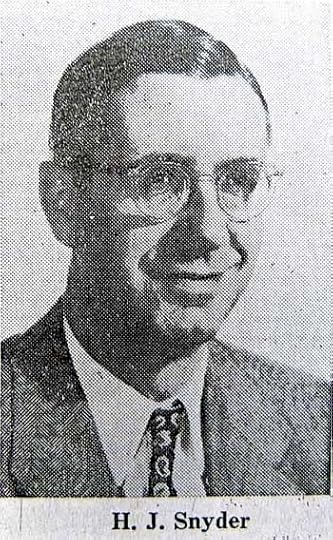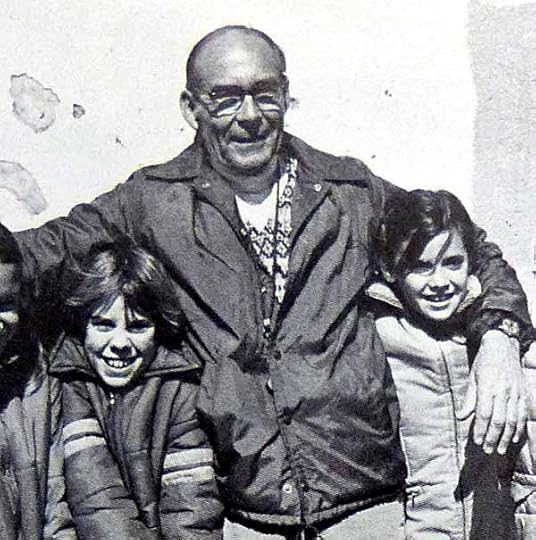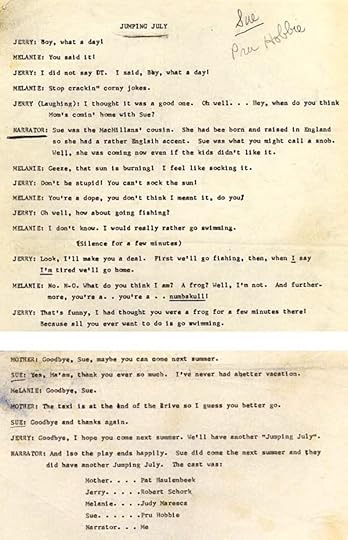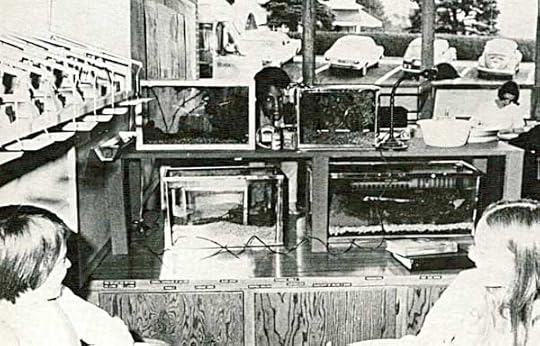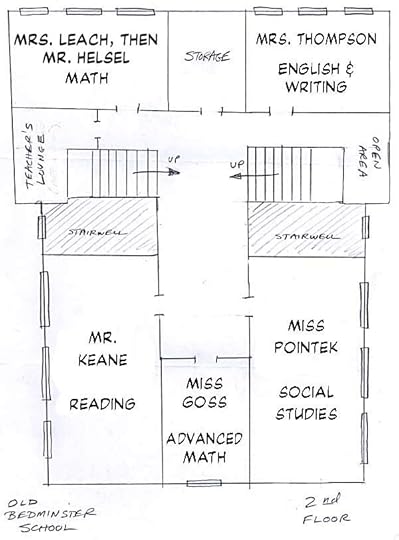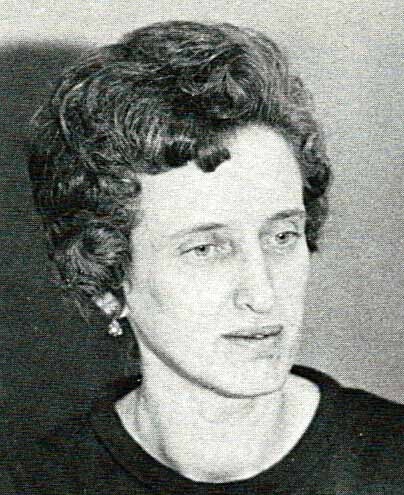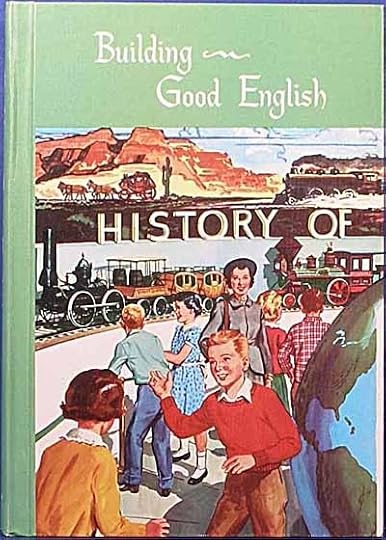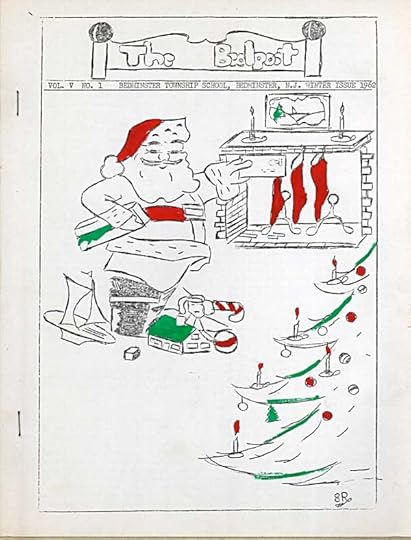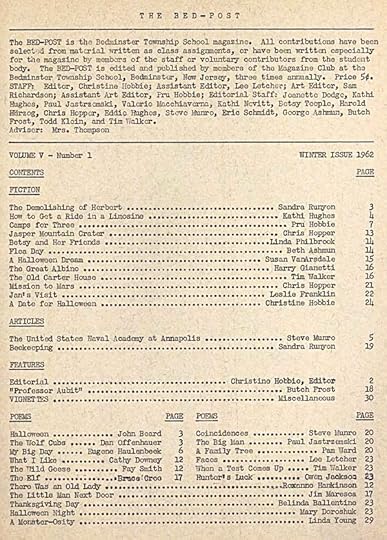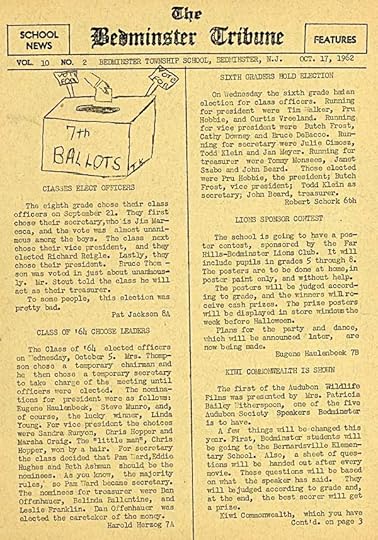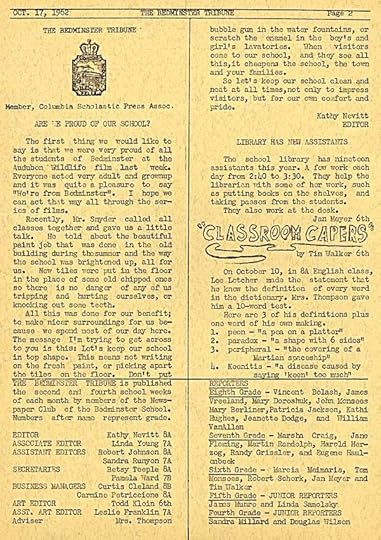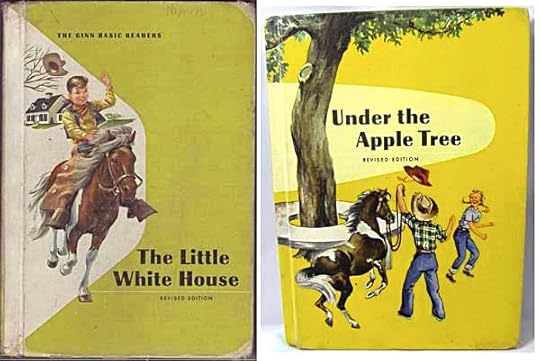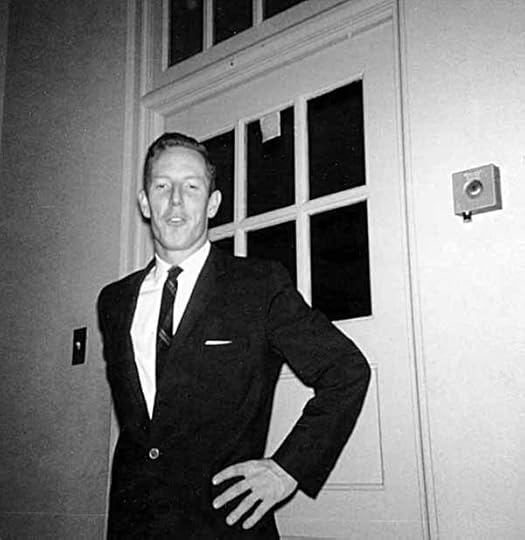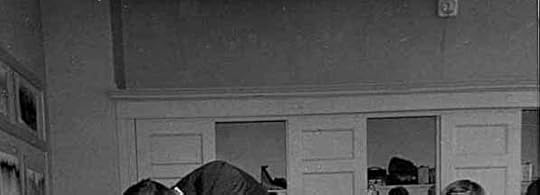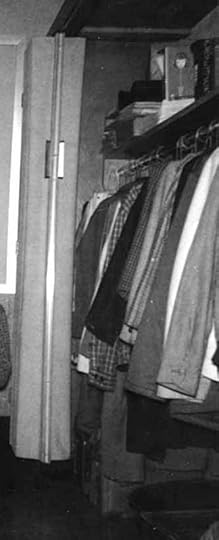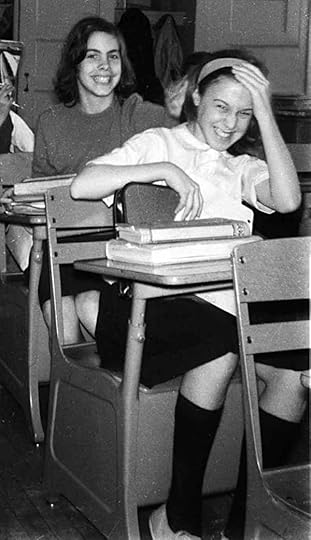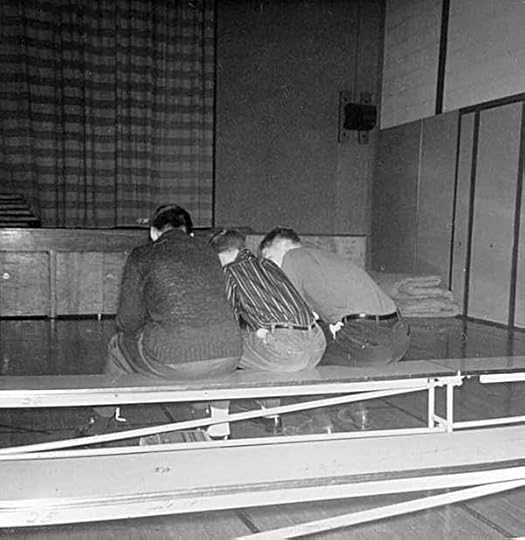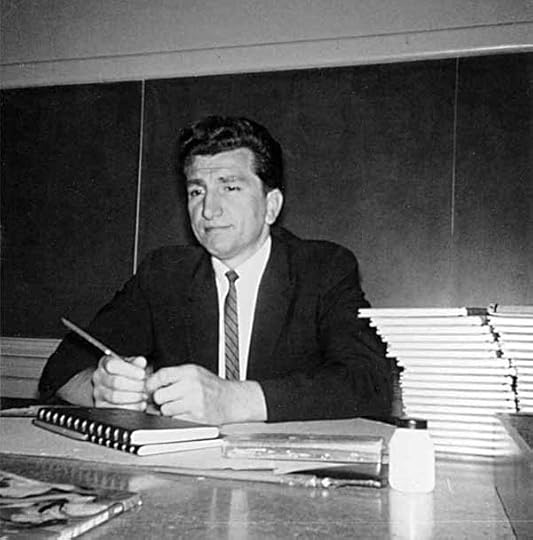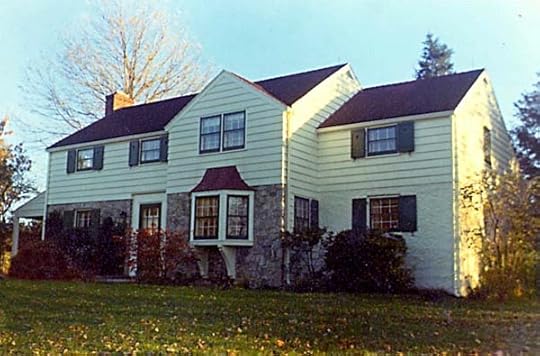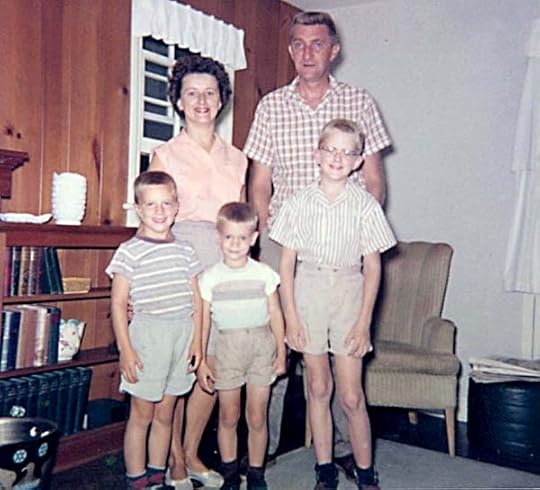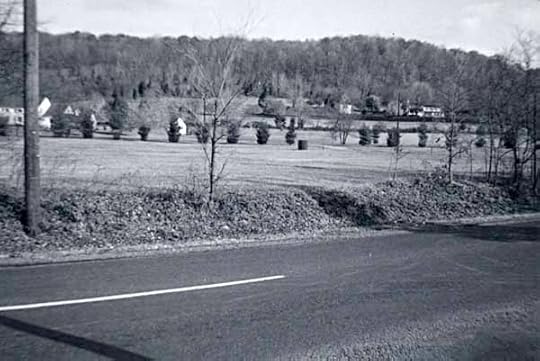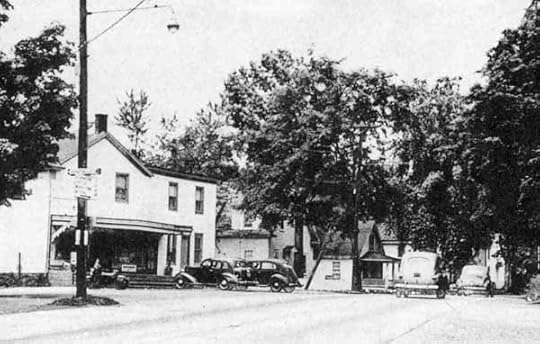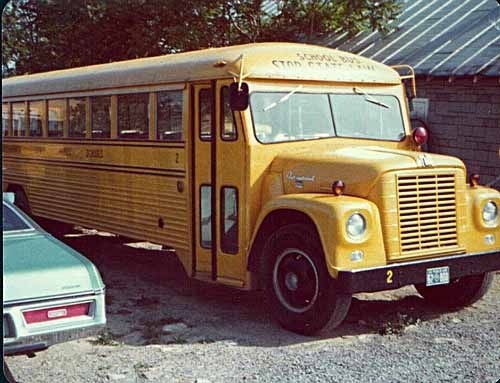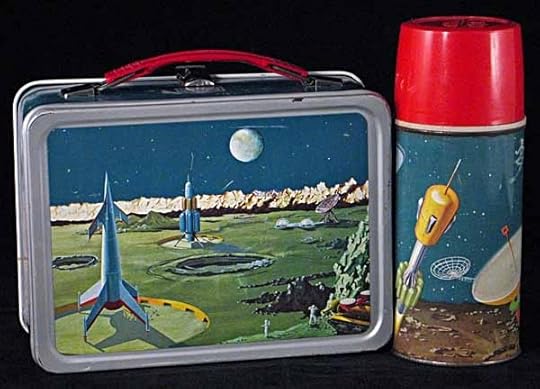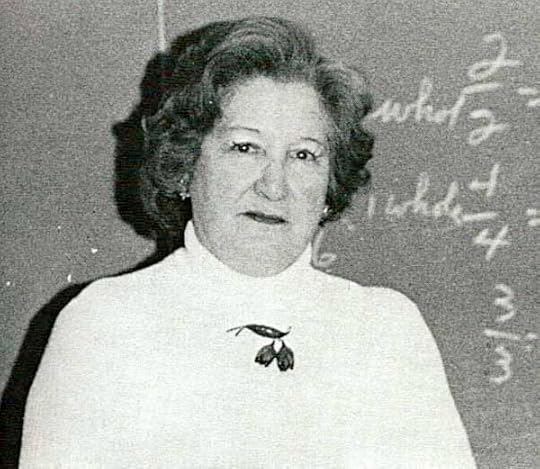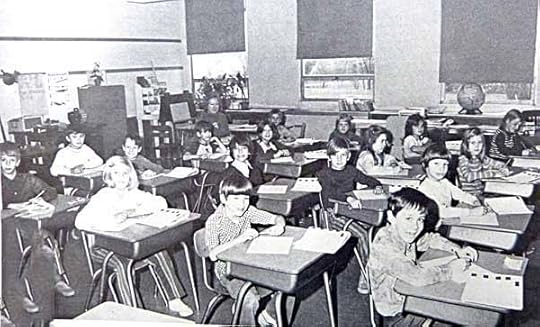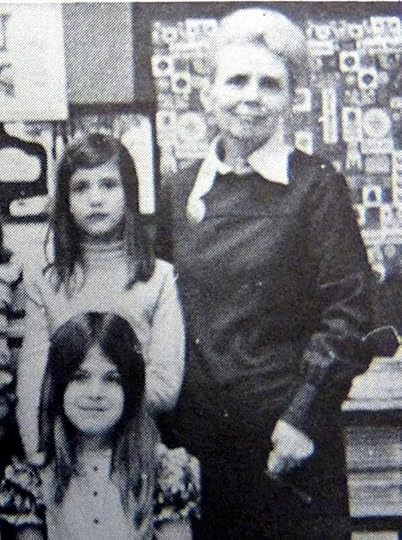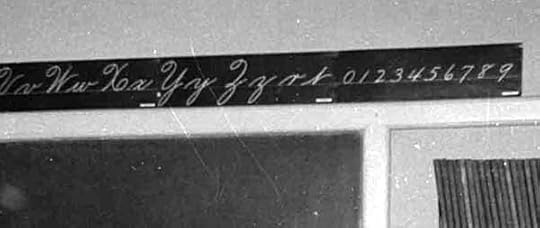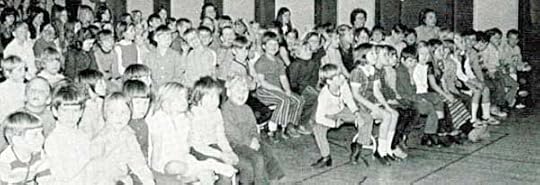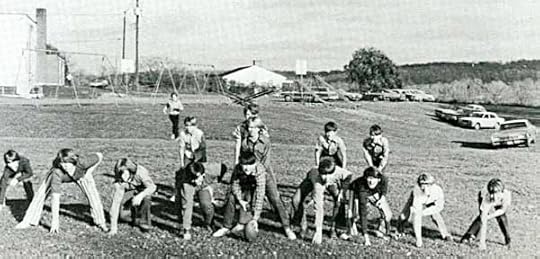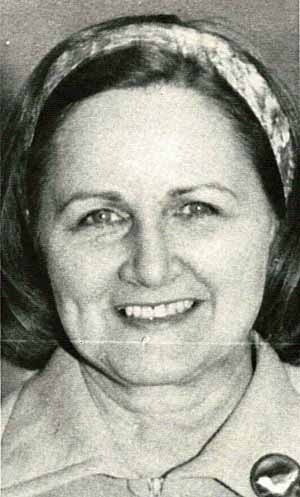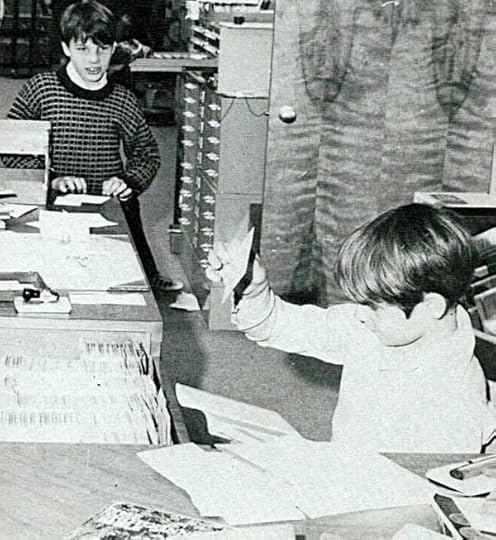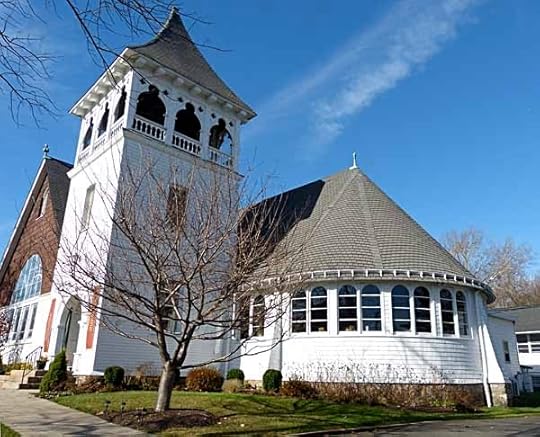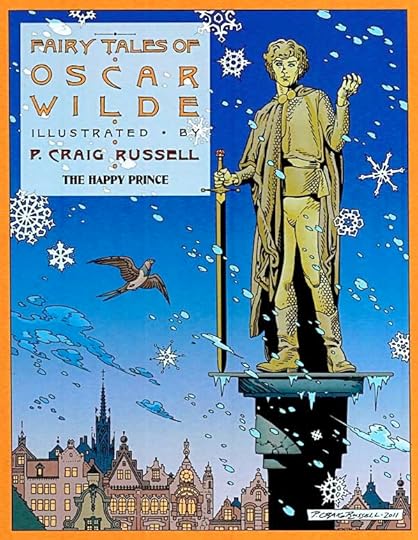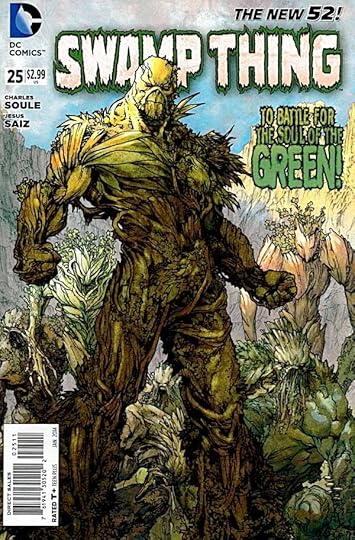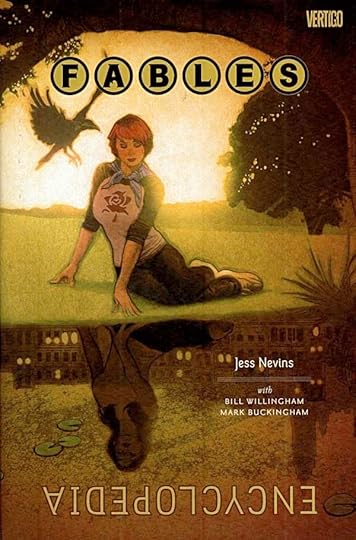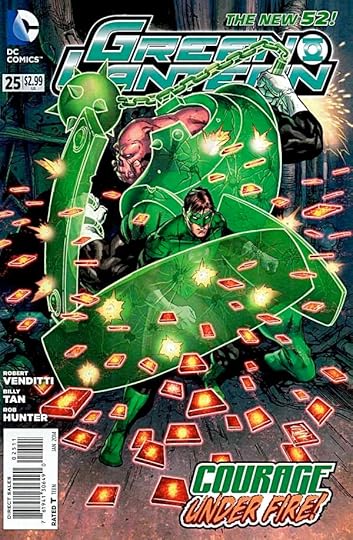Todd Klein's Blog, page 257
January 17, 2014
Bedminster School Remembered Part 5
On June 22 we graduated. This single sheet of folded paper was the program, done in the usual mimeograph style. Among the school board members are several names I remember from their children attending the school, such as Robert Gitzendanner, who lived in the house across Elm Street from the new building, and James Beard, father of our classmate John Beard.
Another board member, Mrs. Charles (Candace) Ashmun became the director of the School Community Education Program until 1973, then went on to a long career as a politician and environmental activist, and has a large nature preserve in Ocean County, NJ named after her. Photo from 1972. She was also the mother of our classmate George Ashmun, of course.
The board secretary was Miss Mary A. Bowker, the daughter or sister of custodian Charlie Bowker. She was also the school secretary. Photo from 1972.
Inside the program are the full names of all 33 graduates. I can’t say I remember much about the ceremony, but I was given a small award for creative writing by Mrs. Thompson, which surprised and delighted me. Cathy Downey recalls, “I had to work really hard at spelling (thank God for spell check) and that got me high enough grades to be salutatorian for our grade 8 graduation. I made the welcome speech.”
Finally, we have our graduation picture, with everyone looking sharp. A larger version of this picture can be seen HERE. My best guesses at putting names to all the faces:
Top row: Steve Jackson, George Ashmun, Brent Franklin, Roxie Blazure, Edward Ketrow, William Chason, Michael Wulff, Frank Robertson, John Ricciardi, Tom Monsees and Craig Allen.
Middle row: Judy Maresca, Susan Gary, Jan Boyer, Janet Szabo, Susan Van Arsdale, Barbara Haller, Kathy Shinn, Maxine Dixon, Julie Cimosz, Donna Timpson, Valerie Chuhinko.
Bottom row: Cathy Downey, Alfred Herzog, Ralph Johnson, Todd Klein, Harlan (Butch) Frost, Ken Benner, Owen Jackson, Dave Hunt, Robert Schork, Tom Burden and Linda Philbrook.
For the next four years my school bus route brought me to the Bedminster School briefly in the morning and afternoon, and I would sometimes step inside to talk to the librarian, Mrs. Grady, or get books at the library in the church across the street. My brothers continued at the school, with Russ graduating in 1971, and after that we left it behind, and lost touch.
Russ has some memories to add of his years at the school. Above is his grade 8 graduation picture courtesy of Jody Millard. Russ is at bottom left, Jody is fourth from the right.
“I remember the big Halloween poster contest every year. Doug was really into it, too. We had big sheets of oak tag paper, and lots of poster paints, and spent hours making our scary creations. Being the ‘art family,’ Doug always won, and then I took the prize for a couple of years. Contestants got to hang their posters on the walls at the school entrance.”
Doug adds, “The Halloween poster contest was always exciting to me. I think I took grand prize two or three times. The best part was getting those packets of powdered poster paint and mixing them up at home. It was magical.”
Doug also says, “Although I never became comfortable with it, I quickly became tagged as the class artist, as early as Kindergarten actually. By the time I got to grade 4, Mrs. Barlow, known for her enthusiasm for art, had me ear-marked for all kinds of special assignments. I would sometimes be excused from lessons to work on bulletin boards and the like. One time she even took me to visit an adult class she taught at Rutgers at night, where I demonstrated a tempura painting technique. It was a bit daunting having to stand up in front of all those grown-ups and perform for them! But I weathered it. Such was the price of being the class artist at the ripe age of nine!”
Russ also recalls, “I don’t remember any intramural sports while I was there. In grade 8, English teacher Mr. Philip Melovitz (photo above from 1972) knew some of us were into basketball and organized a couple of games with some other schools. I think we just wore our gym uniforms. One of our favorite outside sports was played with those bouncy orange balls – we played baseball and the pitcher rolled the ball to home plate. If you got hit with it while running bases you were out. Indoors, dodgeball was the rage. Two teams on either side of the gym, and we threw balls at each other (I think more than one ball at a time). If you got hit you were out and went into jail at the back of the opposing teams side. If you threw it and an opposing team member caught it, a “prisoner” could be released (you got to pick who). Games went on for a while and I remember Tommy Van Arsdale and I were often some of the last ones left.”
And, “I was in the school band from grades 6 to 8 and played the clarinet. I wasn’t very good so I played the base lines. We had concerts and Mom and Dad came. I think they sounded pretty awful, but we tried. The music teacher was a new young guy, not sure of his name.” Poor Russ, he inherited the clarinet that my parents had bought for me.
Mrs. Thompson was still the English teacher when my brother Doug was there. He remembers, “The teachers lounge was where Mrs. Thompson smoked herself into a stupor. Even without knowing anything about second hand smoke back then, I always felt sorry for the other teachers.”
Some teachers of my class had left, and new ones came in. Doug recalls Mr. Hammond as his reading teacher. Russ remembers a new, young reading teacher named Mr. Spillane who quickly lost control of his classroom. “He was replaced by Mr. Barry Phipps, a huge, portly man with a red face. Besides being intimidating in size, he carried a pool stick with him. Whenever anyone got out of hand, he would slam the stick on the student’s desktop. Scary!” Russ also writes, “By the time we got to grade 5 we had two classes.” His grade 5 teacher was Mrs. Ray, and Russ writes, “Do you know a play called ‘Maria and her Little Cake’? It could have been written by the class for all I know. Mrs. Ray made me play Marie!! It was pretty funny. Mrs. Ray was great.”
Dave Lucas gives us these names: Mrs. Leona Niekerk in grade 2, Mrs. Baim in grade 6, and Mr. John Thomas in grade 7. His reading teacher was Mrs. Westervelt, probably the same one who had given Tim Walker penmanship lessons years earlier. Tim remembers her living near the school. Ellen Burden Parker and my brother Doug recall Mrs. Mary Tiger (above, from 1972) as their math teacher. Ellen writes, “I’ll never forget how she stayed after school to help me. I was a terrible math student, but she never lost her patience with me.” Tom Van Arsdale remembers Mrs. Craig as the regular math teacher and Mrs. Zimmerman for advanced math. Of Mrs. Niekerk, Jody Millard writes, “I recall she had Beatnik Day when we were permitted to wear cut off type ragged edged pants and we all had to lay on the floor on blankets listening to poetry. (I think we took turns reading and Mrs. Niekerk supplied the poems.) Instead of clapping we all snapped our fingers. We thought we were very cool little second graders.”
Russ says, “By the time I went into grade 8 they had added the final wing, and I think there were actually two of each of the lower grade classes, baby boomers in full swing! After I graduated, they changed the old building into the little kids area. As part of my summer maintenance job I helped paint it in wild colors.”
Here are the covers of the 1972 and 1973 yearbooks. The 1972 one has a special dedication to Mr. Snyder on the inside front cover (clearly a late addition) on his retirement. My brother Doug remembers Mr. Snyder had a heart attack when he was alone at the school late one night, and nearly died, but managed to crawl across Elm Street to get help, so I’m guessing that brought on his retirement decision. That year Mrs. Chabot and Mr. Melovitz shared duties as Assistant Principals of the lower and upper grades respectively.
There are many photos within those annuals that I don’t have room for, but some of the teachers and staff mentioned and shown (not covered earlier) in 1972 are Mrs. Margarette Marsden, Administrative Assistant; Mrs. Mildred Barkman, School Nurse (above); Mr. Carl Larsen, Building Custodian; Mrs. Ruth Ahrens, School Psychologist, Mrs. Margaret Mertz, Learning Disability Specialist, Mrs. Phyllis Nordgren, Speech Therapist; Mrs. Catherine Venner; Miss Kathleen Nevitt, Reading and Literature; Mr. James Vath, Science; Mr. Robert Watts and Mr. Richard Ledder, Music; Mr. Richard Bunn, French; Mrs. Ruth Smith, Art; Mrs. Carol Wiederholt, Asst. Librarian and Media Teacher; Miss Weber, Grade 6, Miss Murphy and Mrs. King, Grade 5; Mrs. Homme, Grade 4; Mrs. Mullen and Miss Brzezienski, Grade 3, Mrs. Teisher and Mrs. DeTurk, Grade 2; Mrs. Dalrymple, Grade 1; and Mrs. Thomas (wife of Mr. Thomas another teacher), Kindergarten.
1973 added a new Principal, Dr. Joseph Dispenziere; Miss Kristie Gitzendanner (a former student), School Secretary, Mrs. Michele Mullen and Mrs. Carol Traina, Language Arts; Miss Barbara Thomas, French; Miss Patricia Murphy, Mathematics; Miss Brenda Miller, Music; Mrs. Condon, Sewing; and Mrs. Margret Carton, Physical Education.
Organized school sports are represented in both yearbooks with boys’ basketball team The Bedminster Braves, supported by girls’ cheerleader squads. The School Marching Band continued with the addition of a girls’ twirling squad. Later yearbooks would add more new names, but I haven’t room for them here.
Tim Walker has friends who moved to Bedminster in 1984. They reported that the number of students had fallen by then, with classes below 20 students each. But large changes were coming to the area. New interstate routes 287 and 78 came plowing through the southern part of the township, crossing just southwest of Pluckemin. They took years to complete, but eventually brought lots more traffic and commuters. In 1977 AT&T bought a large piece of Schley Mountain and built a corporate structure there for their Long Lines and Network Operations Center, a few miles south of Bedminster, and they expanded it further in 1987. Many other businesses followed. The restrictive zoning laws that had prevented large-scale development of the area for decades were finally defeated, and soon an even larger part of Schley Mountain, from Pluckemin to Far Hills, became The Hills, a massive housing development, adding many more homes and families to the township. The result was a need for a new and much bigger school.
More land was purchased just south of the school we attended, and a large new structure was built there in the early 1990s, opening in September 1993. It currently has about 600 students, Kindergarten through grade 8. Above is a recent photo I took of it. More recent photos follow. The current school’s website is HERE.
The former campus was empty for a few years, and then was sold to developer Mark Mellilo (Jessica Associates Ltd.) who turned the older building into offices. Another office building in a similar style was built on what had been the front lawn of the school. It’s now School House Village.
The front facade of the old school building is still largely the same, though I’m sure the windows are new.
Of course, inside it’s quite different. Here’s a look from the front entrance down the stairs to the ground floor as it is now.
From the back you can see a new structure added to the south side that houses a large open stairwell and bathrooms on the second floor. Otherwise, the look of the building is much the same as when I was a student there. What we knew as the “new building” was removed, and is now a parking lot.
Beyond the parking lot fence, some of the recreation fields we used for sports like baseball and football are still there, and used by the new school. A path and bridge over the small stream at the south side gives them access.
From the end of Elm Street you can still see the trees on Schley Mountain to the south, though I don’t know that anyone still calls it that.
And here’s something I find fascinating. Remember this picture of the school from about 1914? See that building to the right of it?
[image error]
It’s still there, looking almost unchanged! It seems to be an outbuilding of the house next to the former school, an amazing survivor!
The plaques from the World War One and Two monuments that used to sit on the front lawn of the school have been moved to a new location at the northwest corner of the property next to Route 202, in this well-designed setting, and joined by newer monuments for the Korean War and the Vietnam War. That’s how things look today.
Here’s the current Bedminster Library, the Clarence Dillon Public Library at 2336 Lamington Road, where Tim Walker and I met to do research with the help of research librarians Eric Schwarz and particularly Marie Crenshaw. This article would have been much shorter and less complete without them.
I hope you’ve enjoyed this look back into my own history, and elementary school life fifty years ago. A new page on my blog titled REMEMBERED has been set up for articles like this, that involve personal history and memories rather than those relating to my work. You may find more to interest you there.
If you’re on Facebook, I’ve also set up a Facebook page for the school where you can comment and perhaps connect with former classmates. There will be additional photos and documents there that I didn’t have room for here. Please “Like” it and add to your Favorites to keep up with the latest posts.
SOURCES AND ACKNOWLEDGEMENTS
As stated above, the Clarence Dillon Library was a major source for documents and information. Research help came from Tim Walker, Russ Klein and Jody Millard. Memories and anecdotes from many former students have enriched the article, including some from Catherine Downey and Pru (Hobbie) Cuper, who Tim and I were able to find and reconnect with recently. Thanks to each and every one of you who contributed. Sources include:
The New Jersey Digital Highway, a source for many fine old photos from around the state, including some held by the Clarence Dillon Library.
“The Township of Bedminster” by Frederick Walters, 1964, published by the township to honor the New Jersey Tercentenary (1664-1964). This 8.5 by 11-inch booklet, 112 pages, can be found for sale online, or in pdf format. Walters had lived in Pluckemin for 40 years when he wrote it.
“Images of America: Bedminster” by William A Schleicher and Amanda R. Schleicher, by Arcadia Publishing, 1998. A good printed source of early 1900s photos, many by Edythe Van Doren, and some later photos.
serioustoyz.com (Satellite Lunch Box photo).
Spectrum 1972 and Flashback ’73 Bedminster Township School yearbooks courtesy of Jody Millard.
Personal photos and documents of Tim Walker and Todd Klein.
“The Somerset Hills Exponent” newspaper, archived clippings at the Clarence Dillon library.
John Glenn photo from a movie camera installed in his space capsule, NASA.
The Kennedys at Love Field, Dallas, Texas just prior to the assassination is an Associated Press file photo.
The Beatles on Ed Sullivan photo from MGNOnline.
Bernards High School photo from the 1969 yearbook.
Old Metropolitain Opera House photo by Henry Grosinsky, Time & Life Pictures/Getty Images.
Other unattributed photos were found on Google Images.
January 16, 2014
And Then I Read: SKORPIO by Mike Baron
Image © Mike Baron.
I’m a huge fan of Mike Baron’s comics writing, especially on NEXUS, so I was delighted when he offered me a chance to read and review his new novel. This cover image is dramatic and scary, clearly a supernatural being of some kind, full of evil intentions and leading a vast army of scorpions. In the book, the menace remains mostly unknown until near the end, though early on we have a taste of what it can do.
The story begins with two college students about to drive into a very remote and barren section of the Arizona desert in 1985, searching for the remains of a rumored lost tribe of Native Americans, the Azuma, from the last outpost of civilization, a bar in Gap, AZ. They have it all planned out, and the trip seems to be leading to some amazing discoveries, but trouble is just ahead of them in the form of a massive sandstorm and even more deadly danger.
Cut to the present day, and the main protagonist, Vaughan Beadles, a professor of Anthropology at Creighton University near Chicago. Vaughan is a very happy and successful man, smug even. He’s the star of his department, presiding over a new collection of artifacts from his specialty, the lost Native American tribe of the Azuma, and a huge new grant as well. He has a beautiful trophy wife and young son, a nice home and cool sports car. Vaughan is proud of his position and accomplishments, and as you might imagine, is due for a fall. When the fall comes, it is miles down. Before he knows it, Vaughan is in jail, accused of theft and homicide. His wife has left him, the town and public opinion are scathing, he’s deeply in debt to his lawyers, and his entire world is overturned. The key seems to be that Azuma collection. If Vaughan can only prove his theory about where it came from, he might be able to salvage at least some of his lost life. He heads for the barren desert of Arizona.
A third thread begins in Las Vegas. Summer, a nude dancer at a club is being treated very badly by her cruel and jealous boyfriend, Vince. It’s been going on for some time, and she’s finally had enough. She drugs him, steals his car, and heads for her old home on a reservation. There, her family is dirt poor and of no help, but the tribe’s medicine man gives her good advice, and sends her on a quest for help and answers to the desert of Arizona. In her wake, her boyfriend Vince is hot on her trail, and leaving a path of death and mayhem of his own.
The story is a little slow to develop as it pauses for each new player’s introduction, but by the middle of the book, when all the players have gathered in lonely Gap, Arizona, the storyline explodes into thrilling action and suspense that will have you glued to the pages. It’s one hell of a ride, and in the final act in the desert, when the menace on the book’s cover finally comes for the remaining players, Skorpio is a thriller you won’t soon forget.
Highly recommended.
Bedminster School Remembered Part 4
I have all my report cards from Bedminster. As you must know by now, I’m a saver. Here’s the grade 6 one. The grading system was unusual. Rather than using letters A to F, as most schools did, our school used E: Excellent, VG: Very Good, G: Good, P: Passable and F: Failing. As you can see I was not a top student, with most marks being VG, equivalent to a B grade. In Phys. Ed. I got only G’s, there were two E’s in music and mostly G’s in Writing. In Behaviors and Work Habits, and in Health Education the grades were either S: Satisfactory, U: Unsatisfactory or I: Interview (with parents) requested. Don’t think I ever received any of the latter two. In the teacher’s comments, first marking period, Mrs. Haring noted I was often “inattentive” in her Science class, and that I was “capable of much better.” That must have gotten to me, or my parents did, because by the second period I was “active and attentive in Science classes.” My grades were good enough to be promoted to grade 7. Whew!
Another fad we went through in grade 6 was developing and collecting signatures or autographs. I have several sheets of them from kids in that class, and one from grade 5. This is the envelope our report card was sent home in for a parental approval, and at the end of grade 6 I apparently used it as one might use a yearbook to collect signatures of teachers and friends. Teachers represented are Pointek, Keane, Stout, Haring, Thompson, Leach and Ragno, with a note from Mr. Ragno to “take up an instrument this summer.” (I did try clarinet. Hated it.) I think Julia W. Lutter was also a teacher, but I don’t know of what grade or classes. At bottom left is the signature of our custodian, Charles Bowker. My name is written by homeroom teacher Mrs. Haring, and some classmates are here: Tim Walker, Ralph Johnson, John Beard, Steve Jackson, Pat (Frank) Robertson, Robert Schork, Curtis Vreeland, Owen Jackson, Tom Monsees, and Brent Franklin. Two older boys, Lee Letcher and John Zimmerman were neighbors at home, but in a higher grade. You can see a few of the fancy flourishes and underlines that were then popular among us.
I don’t recall any organized sports teams in my years at Bedminster, though I did find one mention in the school paper of a “first soccer game to be played” between girls from Bedminster and Mount St. John Academy, and on Feb. 27, Bedminster’s basketball Team played against St. Bernard’s School. I think inter-school sports for our age level were just getting started then. So, what else was going on in and around school? Following are some items from “The Bedminster Tribune” in 1962-63. A number of kids had birthday parties in their homes, including a “Prison Party” for Chris Hobbie on Sept. 8, at which “there was dancing and games involving prison sentences and penalties.” Douglas Smith, a third-grader, fractured his arm on that dangerous slide in the playground on Oct. 10. There was a fundraising effort by grade 8 students selling magazine subscriptions that raised about $1,400. Neighboring Peapack-Gladstone’s school had a square dance on Oct. 13 attended by many Bedminster students.
For those with money and horses, or those who liked to watch them, the Essex Hunt Club held their annual Hunter Trials on Oct. 28, and in November had their annual race meeting. Above, a running of the hounds begins at the estate of Kenneth Schley on the Lamington River, 1936. Cathy Downey recalls, “Maxine Dixon was my friend and her father worked for one of the very large estates in the area. Maxine and her father rode in the foxhunts. After President Kennedy died, Mrs. Jacqueline Kennedy and her son and daughter would come to our area for fox hunting. We sat next to them in church sometimes. The foxhunt would come through our back yard, and I remember the sound of the fox horn, the baying dogs, and the pounding of the hooves over the hard fields behind our house.”
On Halloween, the paper reports, “Mr. Stout and Mr. Snyder hid in the red barn next to the school and watched what went on. Some people soaped windows and others put pumpkins down the chimneys.” I expect there were some punishments given out for that. Those crafty administrators! The paper also reports Mrs. Thompson’s house was raided, the windows soaped and toilet tissue strewn around the yard, but “the children responsible had to show up for a clean-up party.” Grade 5 students had a party to welcome Mr. Hoblak, who must have replaced Mr. Nelson. Above, a rare movie reference in the school paper.
A list of Top Ten pop songs begins in the Nov. 14 issue, where the top spot went to “Big Girls Don’t Cry” by the Four Seasons. Also on the list are “Monster Mash” by Bobby “Boris” Pickett, and “Return to Sender” by Elvis Presley. This may have been copied from a newspaper or radio show. The Dec. 12 issue leads with plans for a Christmas program. Mr. Ragno and the chorus were hard at work on some carols, the grade 8 students were preparing a “skit,” and Mr. Keane would be directing the “Christmas Story.” The school band was also practicing for their appearance.
On Jan. 16 there was a talent show with acts performed by students from grades 6 to 8. Our class featured “Radio Announcement” by Tim Walker and Billy Barr, “Jumpwell” by Maxine Dixon, Pru Hobbie and Janet Szabo (clearly about horses), and “Laurel and Hardy” by Pat Robertson, Butch Frost and Robert Schork.
As we moved on to grade 7 in 1963-64, Tim Walker and Pru Hobbie left our class. I was sad to see them go, but at least Tim and I kept in touch. Families were always moving in and out of the area in our mobile society. A new arrival in Pluckemin and our school, then Bedminster when he moved there, was Tom Burden. Tom and I hit it off well right away, and became good friends, spending a lot of time together in school and out. Though we lost touch for a while after high school, we reconnected about 15 years ago, and remain good friends today. Other new arrivals were John Ricciardi, and Barbara Haller. Richard Rodenbach returned to Bedminster after being away for one year. A new grade 4 teacher, Mrs. Winifred Zimmerman (above), and her family moved to Pluckemin, and soon to a house they built down the street from us. Her children were already in the school, her son John had signed my Grade 6 report card sleeve. Her son Billy became a close friend of my brother Doug. Mrs. Zimmerman became good friends with Mr. Ragno, and played piano for his concerts. Later she became the new Advanced Math teacher after Miss Goss died. Mrs. Zimmerman’s father Frederick Walter, a long-time Pluckemin resident, was the author of the 1964 booklet about Bedminster that I’ve used for reference in this article.
Here’s other news culled from the only “Bedminster Tribune” issue I still have from this year. The number of desks in the school was about 273. Mrs. Grady, the librarian got paid for only 3.5 days, the rest of her time at school was as a volunteer. The number of boys in the school was 137, the number of girls was 127, so the total enrollment for the 1963-64 season, at least when the count was made in October ’63, was 264. The top TV show was “The Outer Limits,” followed by “The Beverly Hillbillies” and “McHale’s Navy.” Grade 7 elected class officers were Butch Frost, President; Robert Schork, Vice President; Todd Klein, Secretary; and Ralph Johnson, Treasurer. Again, I have no memory of those elections or class meetings, which were meant to show us how democracy worked, I think.
One thing that was new in grade 7, the class was split in two, 7A and 7B. I don’t know how the split was decided, but it was not alphabetical. From evidence in the school newspaper and magazine, where writer credits were followed by the grade, I know the following people were in 7A and later 8A (which seems to be the same group): Tom Burden, Cathy Downey, Brent Franklin, Butch Frost, Roxanne Hankinson, Steve Jackson, Ralph Johnson, Todd Klein, Marcia Meimaris, Tom Monsees, Robert Schork, Janet Szabo, and Susan Van Arsdale. Our homeroom teacher was Mrs. Thompson, so perhaps it’s no surprise that there are more A class credits in the school publications, on which she was the advisor. Tom Burden remembers, “Mrs. Thompson was a true inspiration. She made me editor of ‘The Bed-Post’ when I hadn’t been there even a year.” The only students that I know for sure were in 7B and 8B are: Susan Gary, Craig Allen, Owen Jackson, and Linda Philbrook. This may explain why I don’t remember some of the other students as well as the ones in my half of the class. I don’t recall if we were all together for Physical Education, recess and lunch, but that seems likely.
While I didn’t think it was right to include Tim Walker’s candid photos of our classmates, a posed official school picture of our grade 7 class, taken November 14, 1963, seems appropriate to use. A larger version is HERE. Tim and I have gone over the faces and tried to identify the students. We may be wrong in a few cases, but these are our best guesses.
Top row: Kathy Shinn, Roxanne Hankinson, Craig Allen, Janet Szabo, Brent Franklin, Maxine Dixon, Donna Timpson, Judy Maresca, John Ricciardi and Richard Rodenbach.
Second row: Roxie Blazure, Bruce Cree, Susan Van Arsdale, Edward Ketrow, Linda Philbrook, Bruce De Bacco and Marcia Meimaris.
Third row: Dave Hunt, Susan Gary, Tom Monsees, Steve Jackson, John Beard, Butch Frost, Owen Jackson, Todd Klein and Ralph Johnson.
Bottom row: Julie Cimosz, Robert Schork, Ken Benner, Jan Boyer, Alfred Herzog, Pat (Frank) Robertson and Cathy Downey.
That’s 33, and Tom Burden had not yet arrived in our class, he would make 34. If the grade was split evenly, that would have put 17 students into the A and B classes, which seems about right to me. The smaller class sizes gave us more individual attention, which depending on your outlook could be a good or bad thing…
A week later our school, and the nation were shocked and traumatized by the assassination of President John F. Kennedy in Dallas, Texas. Hilary Walker remembers that her grade 5 class was about to watch an educational TV program on the school’s mobile television, but when the teacher (probably Mr. Hoblak) tried to tune it in, they instead got live news coverage of the shooting. Hilary recalls the teacher turned white, and quickly ran out to tell Mr. Snyder. The shooting was announced on the news about 2 PM our time, from what I can gather, but the later news that Kennedy had died did not air until around 3 PM. Most schools closed early, and ours probably did, too. I’m sure the teachers would have been unable to teach anyway. I don’t recall how my class got the news, but it must have traveled quickly from teacher to teacher, with each of them telling their students. It was a Friday, and at home the TV was on all weekend, as the nation mourned, and watched more shocking developments like the shooting of Kennedy’s assassin Oswald on live TV, which I recall seeing, and the Kennedy funeral on Sunday. The event made the world seem a darker and scarier place to all of us.
Also in our 1963-64 school year, the British Invasion of pop music was sweeping America, led by The Beatles. Their first appearance on the Ed Sullivan Show on Feb. 9 was watched by the vast majority of children in the nation including myself. I remember being more impressed by the hordes of screaming girls in the audience than the music. I was not listening to rock and roll much at the time, and at first found Beatlemania kind of annoying and silly. Some of the girls in our class felt differently, and a few boys too! Cathy Downey writes, “I remember being on the bus and some of the older girls in the back talking about a new band, the ‘Beetles.’ One girl had an album and I slipped to the back seat and got my first look at John, George, Paul, and Ringo.”
A little later, at Tim Walker’s house, he played some of the group’s early releases, and I was taken with the songwriting and George Harrison’s solo vocals on “Do You Want To Know A Secret?” It wasn’t until we saw the film “A Hard Day’s Night” that next summer that I became a true Beatles fan, and have been one ever since.
Without more “Bedminster Tribunes” to refer to, I don’t have much more to say about our grade 7 year. There was a fad among my friends, including Tom Burden and Tim Walker, for making mazes, and some of mine made it into “The Bed-Post,” though the awful mimeograph reproduction made it hard to even see how it was supposed to work. I know I made plenty of them on notebook paper when I should have been doing other things.
Again, I don’t have a lot of details about our grade 8 year in 1964-65. I know we took tests meant to see what kind of career paths we might be heading toward. I think my top result was Forest Ranger, so I’m not sure how well crafted those tests were. We were already looking toward High School, and I think went on a visit to Bernards High (above) at some point to see what it was like.
Here’s one event I’d forgotten completely until I found the program while doing research at the current Bedminster Library, a play put on at the school primarily by students from grades 7 and 8. I don’t know who did the art for this cover, but it wasn’t me.
Above are the setting and cast. Even looking at it, I can’t remember a thing about the play. It was written in 1956, the author Le Roma Greth seems to have been a prolific writer of short comedy plays, many with a hillbilly theme, though this one is not.
The back cover has all the credits. Clearly it was put on for the public in the gym, with support and funds from the Parent-Teachers Association, with Mrs. Thompson advising. I’m not sure what Mr. Snyder’s duties as Technical Adviser might have been, but the school’s custodian, Mr. Bowker was in charge of the sets. My credit for Programs means I stood at the door and handed them out, I believe.
Here’s a poor photo of Mr. Charles (Charlie) Bowker, from an article in the “Somerset Hills Exponent” in 1966, also showing one of the playground swings and the back of the gym. As I recall, he was much loved by the students. The article by Elsie Brown says,
“In the early hours of the morning, before the sun is up and when the only sign of life is an occasional milk truck and the singing of the birds, there’s one man hard at work making sure that all is in readiness for the 8:30 arrival of several hundred children at the Bedminster School. Making sure the boilers are functioning properly, seeing that each classroom is clean and neat…these are the things that Charlie Bowker, custodian at the Bedminster School already has done when most people in the town are still catching a few extra minutes of sleep. A jack-of-all-trades, a source of any and all sorts of information, a friend to each and every student and teacher — these are the qualities which endear Mr. Bowker to students as early as their first day.”
Here’s Mr. Bowker with, rake in hand, outside the school from the 1972 yearbook. That may have been his last year at the school, he’s not in the 1973 one. Both my brothers liked Charlie Bowker, and were often enlisted to help him with things like opening up the benches and tables in the gym for lunch. Doug writes, “Mr. Bowker was possibly the most angelic being I have ever encountered, disguised as a humble janitor. He never had anything but a kind word to say to any of us kids, he took care of all the dirty work around the place (which included cleaning up whenever some kid threw up — a fairly common occurrence), and above all, he seemed to be genuinely contented with his lot in life.”
One important musical event was the 1965 Spring Concert organized and directed by Mr. Ragno, who also arranged some of the music we performed. I was in the chorus, and even get a percussion credit. The selections are a mix of classical standards, folk tunes and spirituals. I remember being greatly moved by “Were You There?”
Here are the entire cast, with children from grades 6 to 8. The parents loved it. I know I was happy not to be in the band, the chorus was more fun.
When we had recess inside due to bad weather, I think a record player was available to play 45rpm singles brought in by the students, and there was probably some dancing, supervised by the teachers. There was an actual grade 8 school dance toward the end of the school year that I went to, unaccompanied. I remember some of the songs we danced to being “Wooly Bully” by Sam the Sham and the Pharaohs, “I’m Henry VIII, I Am” by Herman’s Hermits, and “The Twist” by Chubby Checker, already an oldie. I didn’t date in grade school (too shy and nerdy), but some kids did. “Going steady” was already a mark of social status as early as grade 6. Pru (Hobbie) Cuper remembers Butch Frost was the first boy she “went steady” with, which involved him giving Pru his ID bracelet to wear.
I believe it was some time in this year that I went on a school trip to the old Metropolitan Opera House in New York City to see a performance of “La Boheme.” The bus trip would have been organized by Mr. Ragno. There might have been a similar trip in grade 7. I don’t think I liked the music or singers much, but I remember being impressed with the gilded glory of the building and stage, and the massive sets. We sat in the top balcony, the cheapest seats. This building at 39th Street and Broadway opened in 1883, and would soon close to be replaced by a new theater in Lincoln Center.
Cathy Downey remembers, “In grade 8 we also had a political debate. Because my parents were voting for Goldwater, I got to be on the Republican side of the debate but I lost. I guess my heart just wasn’t in it.”
In May or June of 1965 our class went on a trip to the New York World’s Fair. I also visited the fair with my family, so I’m not sure what things I saw on which visit, but we all thought it was wonderful and amazing. One of the teachers that came with us was Miss Goss, and she had a hard time keeping up. We didn’t understand why then. Roxie Blazure recalls another teacher who came with us, Mr. Helsel. “He was rather quiet until our trip to the World’s Fair. Then it was like he opened up once we left the school parking lot.”
Next time, my graduation and on to the school as it is today. Other parts of this article and more you might find interesting are on the REMEMBERED page of my blog.
If you’re on Facebook, I’ve also set up a Facebook page for the school where you can comment and perhaps connect with former classmates. There will be additional photos and documents there that I didn’t have room for here. Please “Like” it and add to your Favorites to keep up with the latest posts.
January 15, 2014
Bedminster School Remembered Part 3
The principal of our school my entire time there was H.J. (Jake) Snyder, seen here in a 1961 article from “The Somerset Hills Exponent.” The article says he started at the school as an English teacher in 1947, and became the supervising principal in 1951. He and his wife Mildred had two children who attended the Martinsville schools, so he must have lived in that area east of Pluckemin and outside Bedminster Township. His hobbies were gardening and woodworking. He described the biggest headache in his job as being “transportation.”
Mr. Snyder seemed to me a very kind man at heart, perhaps a little high strung, though he could be stern and harsh when he needed to. Bad kids were sent to the principal’s office, where he would often let them cool their heels on a chair outside for a while, thinking about their offenses. I have to admit I was a good kid, so this only happened to me once. When I finally was called into his office, Mr. Snyder asked me a few questions, sternly reminded me of the rules, and sent me on my way with a smile and no punishment. Some kids were not let off so easy, and could be expelled for a week or more, or given extra work, either physical chores in the school or homework I think. Catherine (Cathy) Downey remembers being sent to his office for talking in class. “I cried and cried while sitting on the principal’s bench, and he just let me go back to class.” My brother Doug recalls having to go to the Principal’s office in grade 3 to read a report to Mr. Snyder all by himself because Mrs. Chabot was so impressed with it. ”I think the report was on cotton, of all things. He was very pleased with it. I was sweating bullets.” Jodi Millard writes, “I confess…I had to stay after school and write on the chalk board ‘I will not talk in class’ something like 100 times. I think once I had to do it on paper 500 times. (sigh)”
The assistant principal was William Stout, seen here in a 1979 photo with some of his students. Mr. Stout was also the Physical Education (Gym) teacher. According to a “Bed-Post” article, he began teaching in 1948, and his favorite hobby was riding horses. He was the real disciplinarian of the school, with a sharp eye and a loud bark when warranted, but also a fair and generally kind man, even with wimpy kids like me, who were awful at all kinds of sports. Cathy Downey remembers, “Mr. Stout was really very fair when it came to girls and boys being given equal opportunity at sports. We all played soccer together. We had quite a gymnastics collection with ropes and parallel bars, a vaulting horse and rings. My only complaint was that the girls had to have two hours a week of Home Economics, and the boys then got a double period of PE (Physical Education). I remember looking out the window at the boys running and playing while I sat in a chair learning the cross-stitch and basic machine sewing. Miss Poindexter was the teacher and she was really quite good. To this day I love hand sewing.” My brother Russ recalls, “Mr. Stout was a really in-shape guy. He was stern, but also had a heart. I remember his wife would substitute for him sometimes — she was also a really in-shape person.” Pru (Hobbie) Cuper writes, “The Stouts were definitely memorable! I was scared to death of Mr. Stout but really liked his wife. The square dancing in gym class was fun (mad rush of boys who were allowed to pick a girl to dance with…which, of course, is a pretty cruel system by today’s standards). The gymnastics were definitely NOT my favorite. I also remember a variation of dodgeball (nicknamed Killer Ball) that involved boys hurling the ball at people’s heads. I remember watching a girl get flattened one day and needing to be taken to the nurse because her nose was bleeding.”
My 1961-62 grade 5 teacher was Mr. Nelson, and neither Tim nor I have any real memories of him, nor have I found any photos or information. Cathy Downey remembers, “Mr. Nelson was my favorite teacher. I thought he was very cool and fun. I think a lot of the girls had a crush on him.” Pru (Hobbie) Cuper recalls, “Mr. Nelson (my all-time favorite teacher) was newly married and his wife had a baby boy during the year he taught us. They named the baby Kenneth Edward Nelson and he told us (with delight) that the baby’s initials were also his first name. One day, Mr. Nelson’s wife brought the baby to our classroom window (it was a warm spring day) and we all got a chance to wave to her (and the baby).”
Tim Walker was still a close friend, and I often talked to Pru, also interested in a lot of the books I liked, especially ones about horses as I recall. There was a group of girls in our class that were horse-crazy, including Maxine Dixon and Janet Szabo. Janet also had a talent for drawing horses, another interest we shared. Here are other things I remember that might be from grade 5. At one point there was a craze for trading pencils. I would trade two or more partly used pencils for a new one, for instance, trying to build up a stock of brand new pencils, a collecting fad. There were often posters and art wanted to decorate the bulletin boards in the main entrance, or the classroom, and even an annual Halloween poster contest. This was something I enjoyed and found I was pretty good at. There were science projects, like making a volcano that erupted with baking soda and vinegar.
There were educational filmstrips and movies. The space program was big news at the time, and I recall being gathered in the gym at least once to see a Mercury astronaut launched from Cape Canaveral on TV, probably John Glenn in Friendship 7 on Feb. 20, 1962, above. The school had a large (for the time) TV on a portable stand. My brother Russ writes, “I clearly remember them rolling a TV into our classroom in 1969, and we all watched the first moon landing. I also remember nuclear attack drills in the early grades. When the siren went off, we had to get under our desks. Like that would have helped.”
In Grade 5 we were joined by Missi (Melissa) Trauger, a girl who liked to write short plays. I have copies of two, above is the beginning and end of “Jumping July,” written and narrated by Missi when the play was put on for our class. Mr. Nelson must have encouraged us to do that. I wasn’t in the plays, but I may have helped in some way, with rehearsals perhaps, which would explain why I have them. I remember being impressed that someone my age (12) could do this sort of thing, and as I recall they went over well with our class. The plays are mostly realistic bickering and teasing between children, with any action off-stage and explained by Missi as narrator, but at the time we thought they were great. This may have inspired me to try writing myself. Pru (Hobbie) Cuper had the lead role in this play, and she remembers, “Missi Trauger was with our class for a very short time. She lived a few blocks from my house and we used to walk to each others homes to play after school.”
In the fall of 1962 I started grade 6, and now began moving around during the day to different classes for a variety of subjects and teachers. My brother Doug entered Grade 2, and Russ began Kindergarten. New students joining us this year were Kathy Shinn and Susan Van Arsdale. The Van Arsdale family moved to Pluckemin, and Susan’s brothers Edward and Tommy became close friends with my brothers Doug and Russ respectively. My homeroom teacher was Mrs. Ida Haring, and I believe our room was in the new building at the corner next to the main entrance and across from the gym. Mrs. Haring was also our science teacher. An article in “The Bedminster Tribune,” our school paper, reports she was a member of the Audubon Society, and the Somerset County Historical Society. She had two daughters, one already a teacher herself, and one studying nursing. Cathy Downey remembers, “Mrs. Haring was an excellent teacher, and it was in her class that I first fell in love with science. Remember the pinhole cameras? She was very strict in that a simple look, if anyone was acting up, would make the classroom into a chilled silence.” I don’t remember the pinhole cameras, an example of how we all remember different things from our school days. I believe the 1973 picture above is from that classroom, at the back looking east out the windows to the row of parking spaces on the far side of Elm Street. The equipment is all new to me.
Here’s that diagram of the upper floor of the old building with the names of the teachers in each classroom, as we remember them. From grades 6 to 8 we spent a lot of our day here. Tim and I were in the Advanced Math class with Miss Jane Goss. Miss Goss was a wonderful teacher who taught us all kinds of cool things. Some I remember are the huge numbers up to googolplex, set theory, and mathematical logic. Tim Walker calls her the best teacher he ever had. Unknown to us, she had cancer, and was often out sick, probably getting radiation treatments. I remember her as tall and thin with short hair for the time, and a warm smile. Tim and I were both shocked to learn of her death, I think in 1966, the year after we graduated. I haven’t been able to find an obituary or any other information about her.
Mrs. Rhoda Leach was the regular Math teacher for our class in grade 6. A “Bedminster Tribune” article said she had a number of teaching jobs before coming to Bedminster. She had two daughters and five grandchildren. Mrs. Leach retired at the end of that year, and the new Math teacher for our time in grades 7 and 8 was Mr. Gene Helsel. Tim and I don’t remember these teachers. Tom Burden recalls, “when I came in grade 7, the subject was ‘new math,’ which made no sense to me, and at the time the country was pushing the metric system, unsuccessfully, as it turned out.”
Miss Catherine Pointek, here in a 1973 photo, was our Social Studies teacher. She began teaching at Bedminster in 1952, according to a “Bed-Post” article. I don’t remember much about her, or the class, but I think I liked it well enough. Social Studies covered the United States in early grades, moved on to the countries of the world in later ones. We learned about each state and country’s people, customs, natural resources and so on, with some history. Cathy Downey remembers, “Miss Pointek was a fine teacher, but I remember being compared by her with my sister Louise who was six years ahead of me with a genius IQ.” Pru (Hobbie) Cuper writes, “My sisters and I recall Miss Pointek telling stories about the town in Pennsylvania where she grew up. Most of the stories were somewhat alarming, involving crimes that had occurred in the town (not sure why she felt a need to share those with us!). There were a few students who were incredulous. She would reply, ‘You don’t believe it? Well, it’s true!’”
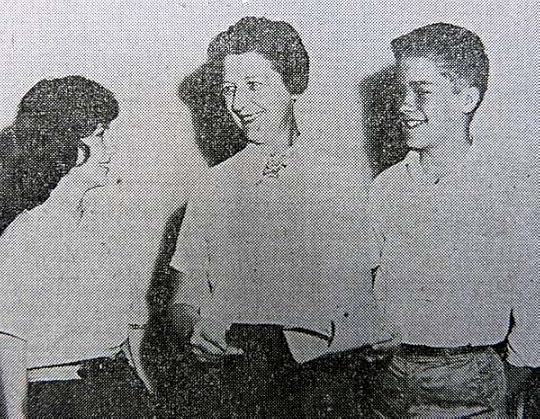 TOP PRIZE WINNER at the Columbia Scholastic Press competition this year, the Bedminster School’s student newspaper, “The Bedminster Tribune,” is proudly held by the faculty adviser, Mrs. Helen Thompson, as she commends the two student editors, Boby Lou Cramer, at left, and Steve Strait, at right. (From the “Somerset Hills Exponent, May 25, 1961.)
TOP PRIZE WINNER at the Columbia Scholastic Press competition this year, the Bedminster School’s student newspaper, “The Bedminster Tribune,” is proudly held by the faculty adviser, Mrs. Helen Thompson, as she commends the two student editors, Boby Lou Cramer, at left, and Steve Strait, at right. (From the “Somerset Hills Exponent, May 25, 1961.)
My favorite teacher was Mrs. Helen Thompson, who taught us English, which included proper use of grammar and punctuation, sentence structure, tenses, and things of that kind. A “Bed-Post” article says she began teaching in 1959, and was born and lived in nearby Lamington as a child. Her favorite hobbies were boating, playing the organ, and gardening.
Our textbook in grade 6 was this one, “Building Good English” by Harold Gray Shane. In Mrs. Thompson’s class there were often examples of humorous word play and puzzles. One that sticks with me was about punctuation. Miss Thompson wrote out the following on the blackboard: THAT WHICH IS IS THAT WHICH IS NOT IS NOT IS THAT IT IT IS, and asked us to make sense of it. When we couldn’t she added the punctuation: THAT WHICH IS, IS. THAT WHICH IS NOT, IS NOT. IS THAT IT? IT IS! In her class we were also given creative writing assignments, from poems on a particular subject to essays and fiction. She encouraged us to use our imagination and create any kind of stories we liked.
The best of them ended up in the school magazine, “The Bed-Post.” I’ve already written a short article about that HERE. It was usually published three times during the school year. This 1962 cover is by Art Editor Sam Richardson, and each cover was hand painted in two colors of poster paint.
Page one lists the staff and contents, and gives the price: five cents. Of course, these magazines — and the school newspaper, also run by Mrs. Thompson — were subsidized heavily by the school. It was exciting to me at the time to see my name and work in print, and I think many of the students felt that way.
The cover of “The Bedminster Tribune” from Oct. 17, 1962. The paper was intended to come out twice a month but often emerged less frequently, perhaps due to supply or article shortages. These articles were on class officer elections, and at upper right is our grade 6 class. Tim Walker, Pru Hobbie and Curtis Vreeland all ran for class president, and Pru won. I was elected as secretary, though I have no memory of this, or any class meetings. At bottom right is an article about one of a series of National Audubon Society lectures/slide shows we attended that sparked in me a lifelong interest in birds, especially one by Roger Tory Peterson.
The first inside page of the paper lists the staff. I was the Art Editor that year, which meant I drew most of the illustrations and titles, like the one on “Classroom Capers” written by Tim. I had the same job on “The Bed-Post” in grades 7 and 8.
Mr. Michael Keane was our Reading teacher, working with us on reading skills, phonics, and probably spelling too. I think we used the Ginn series of readers and workbooks, examples above, and were probably assigned other books to read as homework, though I don’t remember any in particular.
Here’s our Reading teacher, Mr. Keane, looking dapper in a suit. I don’t remember him as well as Tim does, but an article in “The Bedminster Tribune” describes a trip he took to Ireland, France and England where he participated in sports like football, soccer, fishing and dancing (!), and attended some Irish football games. The photo is surely at the door of his classroom. Note the windowed transom over the door and the high ceiling. This is one of eleven photos taken by Tim Walker in our Grade 6 classes. Many of them show fellow students, and we’ve decided not to use those in full because we don’t have permission from the people in them, though we feel the teachers are okay to use, and I’ve also pulled some cropped images, as you’ll see. Pru (Hobbie) Cuper writes, “Mr. Keane used to let us read plays aloud in class — I remember reading ‘A Christmas Carol’ with a British accent (I was the Ghost of Christmas Past – ‘Pahst’). Mr. Keene got a good chuckle out of this and encouraged us all to try doing the play with British accents.”
In this cropped image from Mr. Keane’s classroom you can see the coat closets in the back of the room with a shelf for lunch boxes, and far above the room’s small clock. The ceilings in the second floor of the “old building” were quite high. The upper half of the windows could be lowered for ventilation in warm weather using a long pole with a hook on the end, but there was no air-conditioning.
By contrast, here’s a coat closet from the new building, in Mr’s Haring’s science class, also our homeroom. It had a soft accordion-style sliding door that was usually kept open like this, I think.
Here’s a larger cropped picture from Tim I can use because we have permission from Pru (Hobbie) Cuper and Catherine (Cathy) Downey, the two people in it. Also Mr. Keane’s room, this shows the “newer” style of desks. There’s a storage area under the seat with the opening on the other side, as you can see HERE.
This photo from another classroom, perhaps Mrs. Thompson’s, shows an older style of desk that has a pencil tray at the top, and a hole at top right meant for an ink bottle or inkwell. Dip pens and ink for schoolwork had long been out of use by the 1960s, we used pencils or ballpoint pens. The top was hinged below the pencil tray and inkwell, with a storage area below. A better look at this type of desk is HERE.
This is an exception we’ve made to pictures of the students, since we can’t identify them and doubt anyone else is likely to. It’s taken in the gym, and at far right in the back you can see a bench and table folded into the wall, while in the foreground are two benches open for seating. This was quite a clever idea, I think. You unlocked them with a key, and they folded out to a length twice the height, hinged in the middle. In the back is part of the stage and curtain, and under the stage were storage cabinets for gym equipment, I imagine.
The last of Tim’s pictures I’m using is of our Music teacher, Mr. Joseph Ragno. He was liked by most of the students. He began at our school in the spring of 1962 after the previous teacher left suddenly. (Cathy Downey, Pru Hobbie and I recall rumors that teacher had been found with drugs.) I remember Mr. Ragno as being funny and very demonstrative and excitable in an Italian way, with a hearty laugh. He also had a notorious hot temper and could lash out at students who misbehaved. Despite that, Pru recalls many of the girls had a crush on him. An article in “The Bedminster Tribune” reports he had begun vocal lessons himself at age 18, also playing in his college symphony and concert band in Lebanon Valley, PA. Later he played with the Ted Blue Quintet (a group I can find no record of) and the United States Marine Band. Mr. Ragno transformed our music education from singing songs around a piano with our previous teacher to an ambitious choral music program and school band. His personality won us over and made us want to create beautiful music for him. I think we did some pretty good concerts. I’ll show the program from one later. Cathy Downey remembers, “Mr. Ragno was the most amazing music teacher. He took me under his wing and I played the clarinet, the flute and the piccolo in band and orchestra and he would have me play all sorts of different parts. I also sang in the choir and loved singing harmonies. He taught us music appreciation and how to hear the different instruments in each symphony.” I remember us learning and singing challenging material in the choir like Rogers and Hammerstein’s “You’ll Never Walk Alone,” and “America” from Bernstein and Sondheim’s “West Side Story.”
More about grades 6 to 8 next. Other parts of this article, and more you might find interesting can be found on the REMEMBERED page of my blog.
If you’re on Facebook, I’ve also set up a Facebook page for the school where you can comment and perhaps connect with former classmates. There will be additional photos and documents there that I didn’t have room for here. Please “Like” it and add to your Favorites to keep up with the latest posts.
January 14, 2014
Bedminster School Remembered Part 2
In the spring of 1960 my family bought this two-story colonial home on the corner of Washington Valley Road and Oakura Lane in Pluckemin, New Jersey. The area was still very rural, with woods and fields, streams and ponds to explore nearby, and my brothers and I did lots of that.
Here’s our family in the early 1960s in our living room, my parents Phyllis and George, middle brother Doug, little brother Russ and myself. No air-conditioning, so shorts were the thing in summer!
From our yard looking northeast across fields and a few houses to the woods of Schley Mountain. This was part of a large Schley estate with a mansion home on the other side in the Far Hills area, but the old carriage roads were rarely used, except by kids like us. The town of Pluckemin itself hadn’t changed much in 200 years, except for paving the roads. The main street had a large church and about twenty houses along a half-mile stretch, many from colonial times. Pluckemin had hosted part of George Washington’s army one winter during the Revolutionary War, and was actually more important than Bedminster back then.
The only businesses I recall when we moved there were a general store (post office and liquor store also inside), a gas station, and a bar, the Pluckemin Inn. There was the schoolhouse just west of town, but it had recently closed. Here’s the general store in 1940, much as I remember it — except for the cars, of course.
When I began at the Bedminster Township School in the spring of 1960, the school bus picked up students in front of the general store at the main crossroad in Pluckemin. I walked the half-mile down Washington Valley Road from our house to the store, or in bad weather was driven down by my mom. One thing that’s changed very little in the intervening 50 plus years is the look of the yellow-orange school buses. Later the bus came up to Oakura Lane, next to our house. The buses came from the Barker Bus Company, also located in Pluckemin.
While parents could buy milk in small cartons for children (from Welsh Farms), given out at the school at lunchtime, there was no cafeteria, so everyone had to bring lunch. Some used brown paper bags, but many children carried tin lunch boxes like the one above, with a matching thermos for hot soup or a drink. I might have owned this one — it looks vaguely familiar! The morning bus ride was a time to talk to friends or finish up a little class work perhaps. The ride was slow, as we stopped often to pick up kids, but probably no more than five miles in all, and took about 15 to 20 minutes.
The bus dropped us in front of the main entrance to the new building, and we dispersed to our classrooms. I began late in the school year in grade 3, and my teacher was Mrs. Marie Chabot. She was something of a terror, very strict, with a loud voice, and always ready to punish with a pinch to the ear or a rap of her ruler on knuckles. Many kids were afraid of her as I recall, but she was easy on me, as I was only in her class for a month or two. Catherine (Cathy) Downey, there for the entire school year, remembers, “Mrs. Chabot would put earrings and jewelry on the boys to punish them and make them dress up as girls. At the time I thought it was cruel and creepy.” Cathy also recalls, “That first year, we had a big musical production for the Christmas pageant. It was called ‘The Christmas Cards’ and it was a story about the old cards from last year being discarded for the new. I had a solo singing part and afterwards the 8th graders would point at me and say that they heard me sing and would I sing on the spot? I felt scared and terribly timid and then Mrs. Chabot chased them away. I heard Mrs. Chabot tell the other teachers that the production took up too much time and that we should never do anything like that again.”
The photo above is the grade 3 class room in 1973, looking much as I remember it, with Mrs. Chabot in the background. The desks had wooden tops, with a storage area below for books and things. The large windows were a distraction often covered by shades to keep us attentive. At the back of the room were shelves with books, and supply cabinets. Coat closets were on the other side near the room entrance, and at the front was the teacher’s desk and large blackboard, though many of those were actually green in our school.
Some of the early acquaintances I made were probably the other kids from Pluckemin like Ralph Johnson, Brent Franklin, and Cathy Downey. Neighbors on Oakura Lane that I went to school with on the bus included Johnny Pierson, Lee and Charles Letcher, Belinda Ballentine, and later Deidre Ballentine. Other early friends were Curtis Vreeland and John Beard. Craig Allen moved to Pluckemin not long after I did, and we spent a lot of time together for a few years.
Students from Kindergarten through grade 4 were all new in the “new building,” which had opened the previous September 1959. All the current grade 3 kids had been at the Pluckemin School previously, with Kindergarten teacher Miss Marion DeVoe, grade 1 teacher Miss Gertrude Koludrovich (Miss Kelly for short) and grade 2 teacher Mrs. Lucy Sprague. All three of them continued at Bedminster. Mrs. Chabot (and grade 4 teacher Mrs. Barlow) had been previously teaching at the Pottersville School before it closed for the consolidation at Bedminster.
In the fall of 1960 I started grade 4 with teacher Mrs. E. Barlow, in another photo from 1973. I remember her being quieter and kinder than Mrs. Chabot, but still strict enough to keep kids in line.
We began cursive writing in this grade, having done only individual upper and lower case letters before that, using as a guide the wall chart above. I liked it, though I was never that good at it. Cathy Downey remembers making a globe out of Paper Mache in this class. Jody Millard remembers it too, placing the wet, starchy strips of newspaper around an inflated balloon, letting it dry, painting it white, then with the green and blue for the oceans and continents. Up through grade 5, students stayed most of the day in their home classroom, except for gym class and recess, either in the multipurpose room or outside in the playing fields and playground. I can remember playing dodge ball and baseball outside, while inside there were calisthenics, basketball and gymnastics. Not sure what grades we started those things. There was also square dancing.
Students gathered in the gym in a 1972 photo, sitting on the foldout benches, with the basketball court markings on the hardwood floor.
Recess was at least a half hour with minimal structure. Above is part of the recreation field in 1972, with the playground behind it: two sets of swings, two see-saws and two slides, with a basketball hoop behind that and then the parking lot for teachers and visitors. (Parking cars on the lower grass to the right is new to me.) The 1960s playground may have had fewer swings, and just one aluminum slide polished to super slickness with wax paper from our sandwiches. It ended on a down slope, as you can see above, and you could get a pretty good launch from it, and from the swings. You could walk around the open field below to the edge of the small stream that formed the lower boundary of the school property. Kids occasionally fell in, and arrived in class with sopping wet clothes. There were also some large concrete pipes meant for drainage or sewer lines that we played on, leading to many skinned knees. I suspect none of this equipment would be considered safe today.
Music and perhaps sometimes art teachers came into our classrooms in the lower grades. There was a piano in each room I think, and our first music teacher came in and played songs for us to sing. I don’t remember his name. Subjects we were graded on were English, Spelling, Reading, Mathematics, Science, Social Studies, Physical Education, Health Education, Vocal Music and Writing, with Art added in grades 5 and 8. My brother, Doug, four years younger, would have started Kindergarten this year.
We also made regular visits to the Library in the lower level of the old building. I was an avid reader, and this was my favorite place in the school. The librarian was Mrs. Dorothy Grady, and we became friends pretty quickly, I think. She introduced me to many books that I still love, like “The Hobbit” by J.R.R. Tolkien, and eventually brought books in from her personal collection for me to read, like the Oz books of L. Frank Baum. The photo above is from 1973. When I started at the school, the library was also the Bedminster town library and had adult books too. My mother loved to read, and she was soon helping Mrs. Grady repair books, either at home or in the room across the hall from the library, I think. Tim Walker’s mother also helped out there once a week, typing catalog cards and other things, as did many other parents.
Here’s the library circulation desk in 1972 with students helping to check out books. I think the boy on the right is putting the card with the due date into the pocket in the back of a book. The door behind him must be for the entrance to the hallway, and the card catalog is behind that.
In late 1962 the town library moved to the large round room in the Dutch Reformed Church just across Route 206 from our school, so the adult and high school level books moved there, and the town bought new books for children to stock it. The existing children’s books remained in the school library. Tim Walker remembers helping move the books, but I missed that somehow. I often walked over to the library at the church — after classes but before my bus left — to take out books, it was a very friendly place. Pru (Hobbie) Cuper recalls the crossing guard, a retired policeman named Charlie Durlach, who she says “always seemed to know what was going on at the school and in town.” The building remains, above is a recent photo I took; it’s now the Grace Fellowship Chapel. The current library is in a large new building about a mile west, and some of the information and photos in this article were found there.
Tim Walker joined our grade 4 class and we soon became good friends. Before long we were visiting each others’ homes often. I’m happy to say we’re still good friends today, and it was on a recent visit with Tim, when we reminisced about these school years, that this project began.
Next time, more school staff and memories. Other parts of this article and more you might find interesting are on the REMEMBERED page of my blog.
If you’re on Facebook, I’ve also set up a Facebook page for the school where you can comment and perhaps connect with former classmates. There will be additional photos and documents there that I didn’t have room for here. Please “Like” it and add to your Favorites to keep up with the latest posts.
January 13, 2014
Bedminster School Remembered Part 1
In recent years I’ve written several articles about comic book history. You can find them on the COMICS CREATION page of my blog. Now I’m trying something different, a series on the elementary school I attended in the 1960s, from grades 3 to 8, in a small New Jersey town. There will be a history of the school, lots of personal remembrances of my years there, and some from other schoolmates. If you’re only here for comics stuff, you might want to skip these, or have a look and see what grade school life was like about fifty years ago.
Bedminster Township is an area in the northwest corner of Somerset County in north-central New Jersey. The name Bedminster was first used for a small town in England, now part of the city of Bristol. It was settled by Dutch, German, and Scots-Irish immigrant farmers in the early 1700s. It contained several small villages, including Pluckemin, Pottersville, Lamington, Larger Crossroads, Lesser Crossroads (the current Bedminster), Peapack, Gladstone and Burnt Mills. Because transportation was slow and difficult, small local schools sprang up in many areas, with a total of twelve in 1867. These were one-room schoolhouses. As roads and transportation improved, schools were consolidated, and by the early 1900s, three larger new schools had been built in Bedminster, Pluckemin and Pottersville for most of the township’s students. Peapack and Gladstone were split off into their own borough in the early 1900s, and had their own school. Far Hills, just east of Bedminster, was part of Bernards Township, then made an independent borough, but because it’s so close to Bedminster, students from there also entered the Bedminster schools.
In 1890 a railroad line was extended from Bernardsville (to the east) into neighboring Far Hills and Peapack-Gladstone. Wealthy businessmen from New York City, who had been colonizing the Bernardsville area, began moving west into Bedminster Township, buying up the small farms and converting them into large estates, where the social scene could include things like fox hunting, horse racing and horse shows. The area remained rural, with very few businesses, but after World War Two the baby boom brought more housing development, and soon more children for the schools. Even with that, the area was lightly populated, partly due to restrictive zoning laws. The 1950 census had 1,613 residents in Bedminster Township, and a 1955 study estimated population at just over 2,000. Compare this to the 2010 census population of 8,165 people. A study of births to residents in the 1950s puts the average at 28 per year. This fits with what I recall as class sizes being 28 to 30 students. If we assume 30 students per class, eight grades plus kindergarten would be 270 students. That seems about right to me, but some classes got a little larger by the time I reached the upper grades.
The first one-room schoolhouse in Bedminster at the corner of Main Street (Route 202) and Elm Street is seen above. It was close to Route 202.
It was replaced in 1914 by a larger two-story building holding four classrooms, two on each floor, set much further back from Route 202. The lower floor was partly recessed into a sloping hillside, and in the photo above you can see that the windows on the lower floor were small. Steps from the front door led down to the ground floor, and the windows were high on the walls there. The upper floors had much larger windows. Color has been added to a black and white photo for this postcard. Note the tall facade above the front doors. It’s hard to see them, but there are two chimneys near the center of the roof that probably serviced coal or wood stoves. The outside walls are of brick, here apparently painted white. In the distance behind is the north side of Schley Mountain, really a wide hill at the western end of the Watchung Mountains.
Another view of the schoolhouse from the early 1920s includes the World War One monument on the front lawn, and shows a little of the side of the school. According to Fred H.L. Field, “The big elm tree on the right was there when I attended the one room school before 1914. Mike King, Liberty Corner NJ. built the new school of two class rooms on the second level and two basement rooms – which did not include inside toilets.”
In 1933 the original school was renovated and a new section was added behind the building increasing the classrooms to four on the upper floor and two larger ones below, with bathrooms and a boiler room, as well as storage areas. The photo above is probably from the 1950s, as it includes the World War Two war monument out front, and looks much as I remember this view of the school in the 1960s. Note the roof line has been changed to remove the facade over the doorway, but that doorway and all the windows match the earlier building exactly. This building was still in use when I began at the school in 1960, but was mainly used by the older students in grades 6-8 except for the library in the downstairs room on the east or driveway side. We called it the “old building,” as opposed to the 1958 addition, or “new building.”
My youngest brother Russ attended the school from Kindergarten through grade 8, and also did maintenance work there as a summer job for at least two years, so he remembers it well, and he’s drawn up a plan of the old building for me.
Here’s the first or ground floor. The top of the drawings is north, facing Route 202. Elm Street is to the right, mainly a wide driveway to the school parking lot and some neighboring houses. There are some areas he’s not sure of, but we all remember the library on the east or driveway side with its own entrance on the south side. The classroom on the west side, opposite, is described in a 1950s report as a “multi-purpose room the size of two classrooms used for program presentations, physical education, vocal and instrumental music, and sewing.” I don’t remember this room clearly, it may still have been used as a music room and/or sewing room when I was there, among other things. The heating system is described in the report as a “coal-fired steam boiler installed in 1933 with no automatic controls.”
The second floor is as we remember it, with five classrooms, storage room and a teacher’s lounge. The “open area” next to the east stairwell had shelves with some old books, possibly an earlier version of the library. I’ll write about the teachers in these classrooms later.
This lot plan from around 1961 places the building in context. You can see the old and new buildings, and the connecting enclosed hallway. Not sure what the square between them represents, there was nothing there that we can remember. The lot was about 6.5 acres.
Here’s an architect’s proposed plan for the “new building” added in 1958, which my brothers and I think matches the building we knew. I’ve added the grades as we think they were set up in 1959-60, when the school opened. Roxie Blazure remembers the classrooms in a different order from grades 1-4, and he may well be right. I don’t recall the area marked for “Arts and Crafts,” though Tim Walker took penmanship lessons there from Mrs. Westervelt and says it was a spacious room with a long table. My brothers remember it later as just another classroom, perhaps two. Two additional classrooms were added in the early 1970s where it says “future C.R. as needed,” with a music room below them. The top of the drawing faces west, the right side shows the beginning of the enclosed hallway to the old building to the north. The lower grades were in the upper part of the drawing. S is for Storage, G. and B. are Girls and Boys bathrooms, with changing rooms for gym nearby. The Multipurpose Room served as a gym most of the day, as well as a lunchroom, and the stage at one end was for concerts, plays, films, meetings and so forth. Tables and benches built into the walls folded out for seating (benches only) or lunch (benches and tables). At the bottom of the drawing, facing the driveway, were the grade 5 and 6 classrooms, the Janitor’s room, and a small kitchen for things like milk (no hot lunches). In corners of the Janitor’s room were tiny offices for the music teacher and the physical education teacher. At lower right we have the administrative offices: Secretary, Nurse and Principal. I’m not sure what W.R. stands for. Wash Room or private bathroom perhaps?
Here’s the only full photo I’ve found of the new building, looking north from the parking lot, with the taller multipurpose room at left, and the old building in the background at the right. The photo is from the early 60s, and is taken from “The Township of Bedminster” by Frederick Walter, published in 1964, as are some other photos I’ve used.
A closer look at the left half of the picture. You can see a fragment of the west wing at left. We think the sports car belonged to music teacher Mr. Ragno, who had a small office next to the Janitor’s room at the time. The tall multipurpose room had high windows covered with curtains, and could be darkened with shades if needed for films.
The right side of the picture shows the canopied entrance to the new building, where school buses would drop off students. Behind is the covered hallway to the old building. Above is the double window of the “small classroom,” and at right the outside doorway to the library, and a window for it. At far right you can just make out the hitch in the roof line where the 1933 addition was added to the old building. My brother Russ recalls, “There was a big display case on the wall to the right of the Principal’s office door. One year (in the later 1960s) Doug and I got to put our old bottle collection in it.”
The only other exterior photo of the new building I’ve found that shows some of the structure is this one from the 1970s of an Arbor Day tree being planted outside the connecting hallway between the new and old buildings. You can see it took an upward jog to accommodate the slope of the hill.
Here’s the interior of that hall showing the stairs and the doors into the old building, which had once been exterior doors. This is Mrs. Barlow’s grade 4 class from the 1972 Bedminster yearbook, “The Spectrum.” Jody Millard has been kind enough to lend me the 1972 and 1973 yearbooks, and I’ve scanned many photos from them, and gathered information there as well. Sadly, there are few exterior school pictures I can use. 1972 was the first such yearbook, we had nothing like that when I was there.
Before the 1958 addition was completed, the township’s three schools had consolidated classes so that all students for Kindergarten through grade 2 were at Pluckemin, grades 3 and 4 were at Pottersville, and grades 5-8 were at Bedminster. After the addition opened in time for the 1959-60 school year, the Pluckemin and Pottersville schools (above) were closed, and all students through grade 8 were bussed to Bedminster, and then on to Bernards High School for grades 9 to 12. The Pluckemin and Pottersville schools probably deserve more attention, but I don’t have room here, but Roxie Blazure reminded me that the Pluckemin School is now the Center for Contemporary Art (formerly the Somerset Art Association).
To finish up this section about school history, here’s an essay by Audell Ray, a Pluckemin neighbor three years older than I, from the Bedminster School magazine, “The Bed-Post” in 1962. It’s well researched, and it includes the school enrollment for that year, 278 children. I found a different year for the building of the early 1900s school, 1914 rather than her 1918, but Audell was a smart student, and I learned some new things from this essay.
Next time I’ll continue with more personal memories of the area and school. Other articles of personal history that might interest you can be found on the REMEMBERED page of my blog.
If you’re on Facebook, I’ve also set up a Facebook page for the school where you can comment and perhaps connect with former classmates. There will be additional photos and documents there that I didn’t have room for here. Please “Like” it and add to your Favorites to keep up with the latest posts.
January 11, 2014
And Then I Read: FAIRY TALES OF OSCAR WILDE 5: THE HAPPY PRINCE by P. Craig Russell
Image © P. Craig Russell.
These over-sized but thin hardcovers, in the European album format I think, are a delight. Wilde’s stories for children are a perfect subject for Russell’s enchanting, poetic and lyrical art. His adaptations are excellent examples of moving fiction to comics the right way. The words and pictures dance together in a gavotte that can only be found in comics. Russell has some variety in his styles, and here he combines elements that are almost cartoony at times with others that are more traditionally realistic, the latter most obviously used for the statue of the Prince, as seen above. The story itself is a Victorian tearjerker of the first water (pun), one of Russell’s best. The only thing better than these slim volumes will be the (I hope) eventual omnibus collecting all of them under one cover. But these individual books are wonderful, and perfect for children, too.
Highly recommended.
January 10, 2014
And Then I Read: SWAMP THING 25
Image © DC Comics, Inc.
If you’ve read T.H. White’s “The Sword in the Stone,” or seen the Disney version, you probably remember the wizard’s duel, it’s one of the high points of both versions. This comic is something like that, a duel between Alec Holland and a rival, Seeder, to see who will continue as avatar of the green. It’s well done, as they use the power of the green against each other, as well as any trick that comes to mind, all in an arena that has a familiar shape, and with the Parliament of Trees as judges. The writing and art on this title continue to be excellent.
Recommended.
January 9, 2014
And Then I Read: FABLES ENCYCLOPEDIA
Image © Bill Willingham and DC Comics, Inc.
I have, thus far, lettered nearly every bit of comics published in the world of FABLES, so it’s an unusual thing for me to be able to simply pick up a FABLES book and read it for pleasure. It happened with the Bill Willingham novel “Peter and Max,” and now again with this volume. The writer of the main encyclopedic text is Jess Nevins, who did such an excellent job of researching and writing about Alan Moore’s LEAGUE OF EXTRAORDINARY GENTLEMEN online and in several tomes from MonkeyBrain Books. He does a fine job here, though is best at unearthing and crediting early versions of familiar fairy tale characters. References to appearances in the comic itself were mostly familiar to me, though I’d forgotten some. Even more fun to read for me were the sidebar comments by Bill Willingham and Mark Buckingham on the characters, how they came to be, why they are as they are, and where they might be headed. This triple-play of authorship really makes the book a fun read, not dry at all. The wit and wisdom of Bill and Bucky had me laughing a lot and eagerly turning the pages. The scholarship of Jess taught me a lot.
Highly recommended for all FABLES fans.
January 6, 2014
And Then I Read: GREEN LANTERN 25
Image © DC Comics, Inc.
When you’ve put a bunch of characters through several rounds of epic battle stories, what do you follow it with? Writer Robert Venditti’s answer is a breather on the new home of the Green Lantern Corps, the living planet Mogo where leader Hal Jordan gets to outline his new plan for all the power rings. Of course, not everyone likes that plan, especially his on-and-off girlfriend (and Star Sapphire) Carol Ferris. In truth, Hal has never seemed to do well with non-crisis leadership, so he takes another path, going after that woman who escaped from Oa by killing one of the Corps. Hal brings help this time, but will it be enough? The art by Billy Tan and Rob Hunter is fine. I’m happy with a less cosmic storyline for a change. We’ll see how it goes.
Recommended.
Todd Klein's Blog
- Todd Klein's profile
- 28 followers



